
Although much is being made of Erik ten Hag’s future at Manchester United, his tactical deployment during the FA Cup final thoroughly defeated Man City.
Having been given a chance at redemption after last year’s FA Cup final defeat to their ‘noisy’ neighbours – not that they could particularly be heard – Manchester United‘s 2-1 victory over Manchester City in this year’s final ended a difficult season on a remarkable high.
It felt particularly poetic that the goalscorers, Alejandro Garnacho and Kobbie Mainoo, were part of the United side that won the FA Youth Cup two years ago. The last time Garnacho didn’t start a game for Erik ten Hag was against this same opposition at the end of October, and yet he worked his socks off until his substitution in the dying minutes of Saturday’s game. Mainoo has been one of the biggest success stories of United’s season, and fans feel hope for the future with him.
Read More: Real Madrid ‘set price cap’ for Manchester United target as three-way battle emerges
A video of those two locked in an embrace with manager Erik ten Hag did the rounds on social media following full time, with fans dubbing them his ‘sons’ and to talk about the game, it is necessary to speak about how Ten Hag set Manchester United up to nullify a side he afterwards referred to as the ‘best in the world’.
Lineup & gameplan – block the middle and force City wide
The Dutchman set United up in a 4-4-2 diamond shape for the game, which sometimes turned into more of a 4-2-2-2 with the forwards, Garnacho and Marcus Rashford, splitting and Bruno Fernandes being joined by one of Scott Mctominay or Kobbie Mainoo. Sofyan Amrabat sat at the base of the midfield, with the two aforementioned central midfielders remaining close to offer him support. Diogo Dalot also inverted from left back on a few occasions.
The intention behind this shape was to compact the middle of the pitch, forcing Manchester City out wide where United could use the touchline as an extra defender and create mini-rondos, trapping City in. City’s use of Phil Foden and Bernardo Silva, naturally central operators, as wingers played into United’s hands in this regard as they outnumbered and dominated City in these situations.
This isn’t the first time Ten Hag’s United has done this. They found success with a similar game plan when Pep Guardiola’s side visited Old Trafford in January 2023.
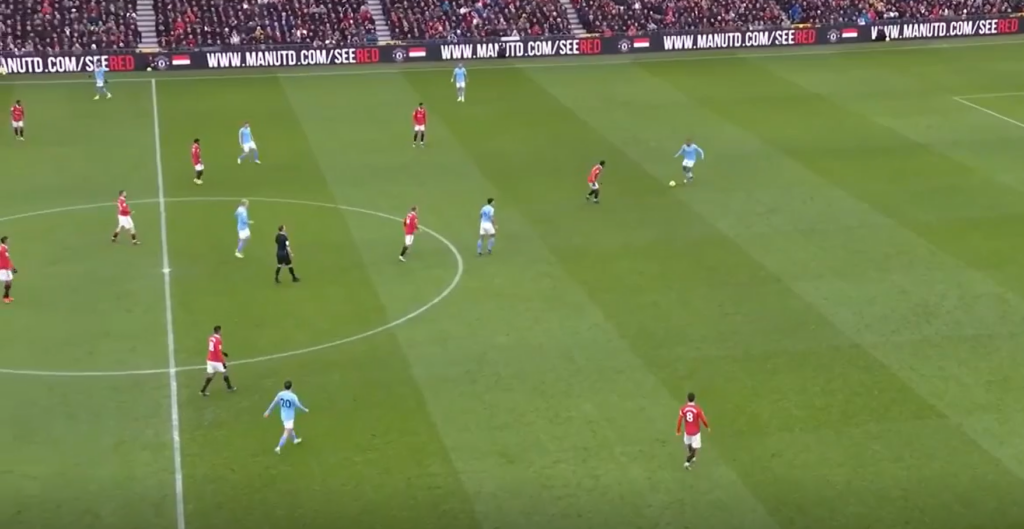
One detail that I picked up quickly about United in the final was how proactive the players were from the very off. Too often this season players have been caught on their heels, being late to the press and not ready to engage in duels, and this has killed United. From the first minute, they were ready to jump on City at the right moments.
In the first screenshot, Walker played through United’s rondo with a good pass, and City were able to transition, but in the second one, United won the ball off Kevin De Bruyne after three players hunted down his loose touch following a long ball being forced.
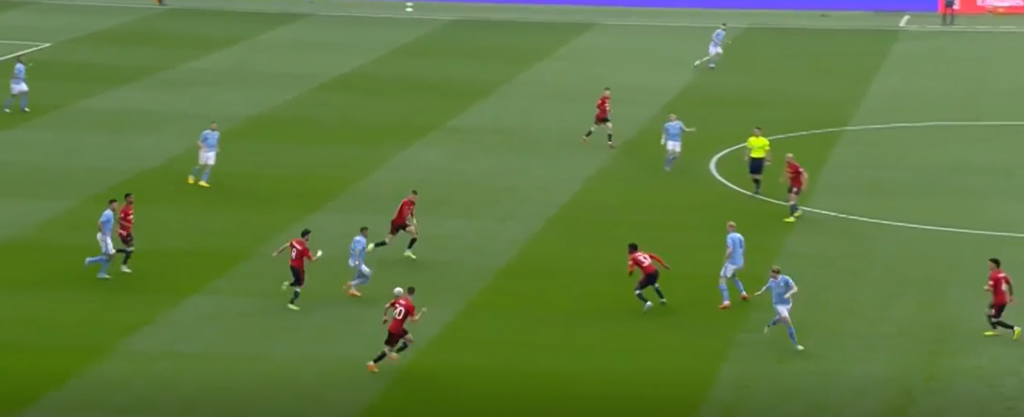
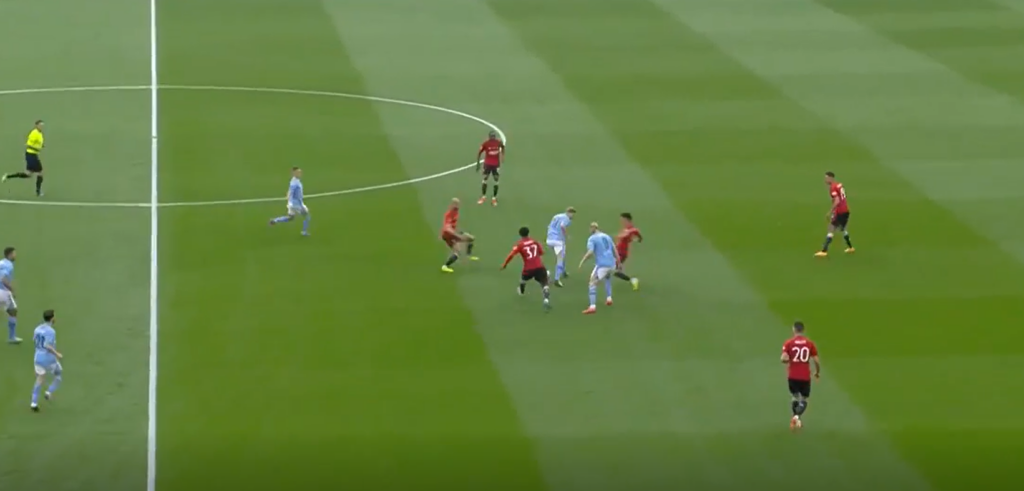
Whilst they set up in a diamond shape nominally, in Manchester City’s first phase of possession, Bruno Fernandes and Scott McTominay often formed a front two, with Rashford and Garnacho splitting slightly wider. United kept City stagnant in the early stages of the game, blocking off the middle and forcing City’s deeper midfielders—Rodri and Mateo Kovačić—to drop deeper to get time on the ball, as seen in the image below.
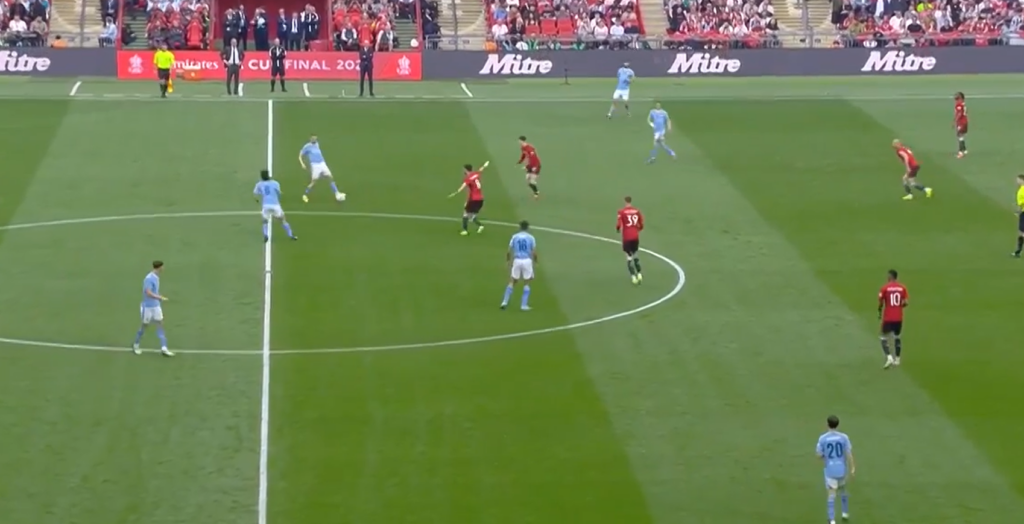
United would often force City into wider areas, where the nearside midfielders, split strikers, and full back were ready to pounce. In the below example, United refuses to let City access the middle, eventually forcing Stones and Walker to try and accelerate play via the flanks. Dalot jumps onto Bernardo Silva with intensity and forces the ball out for a throw-in.
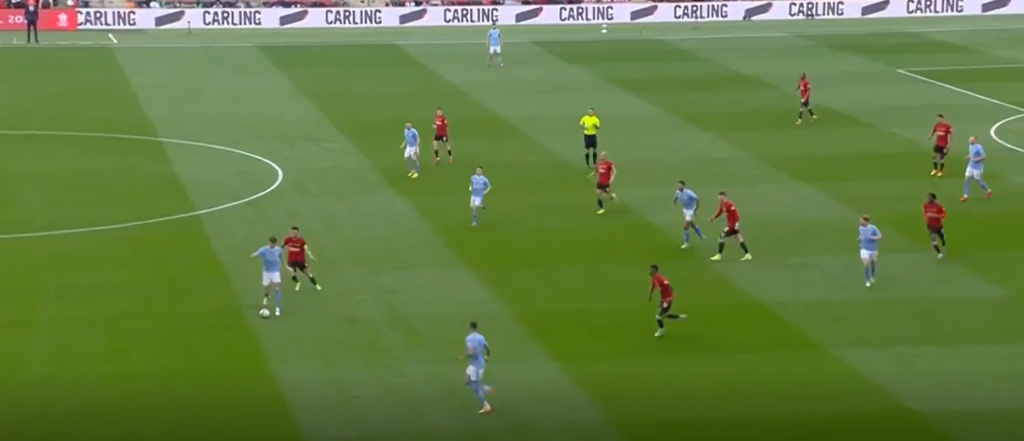
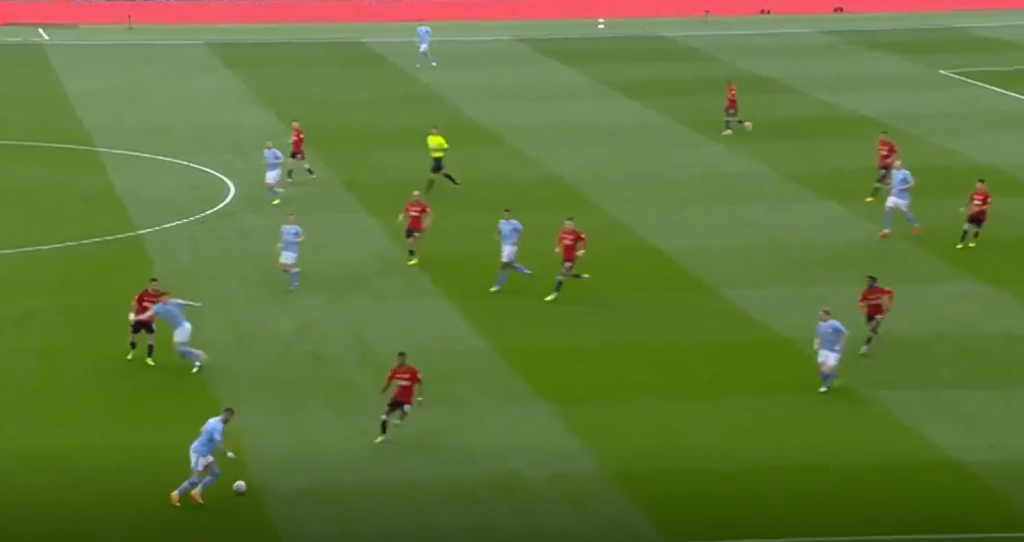
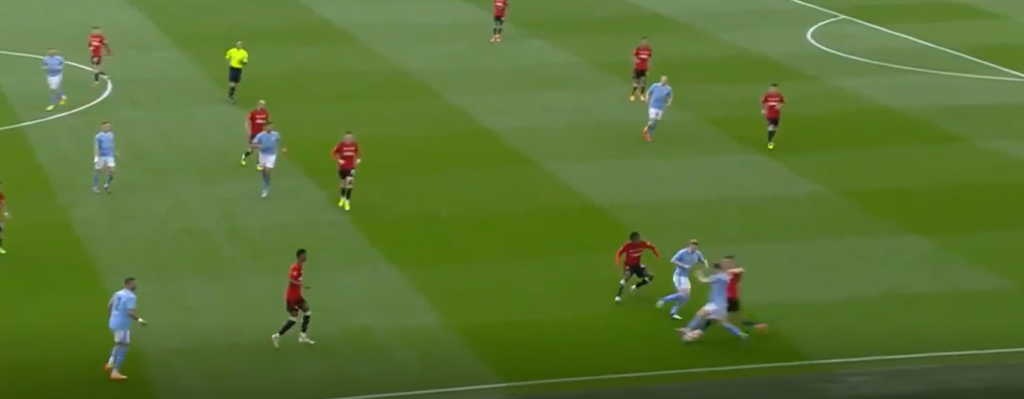
United continued with this setup throughout the first half, making it difficult for City to really threaten them.
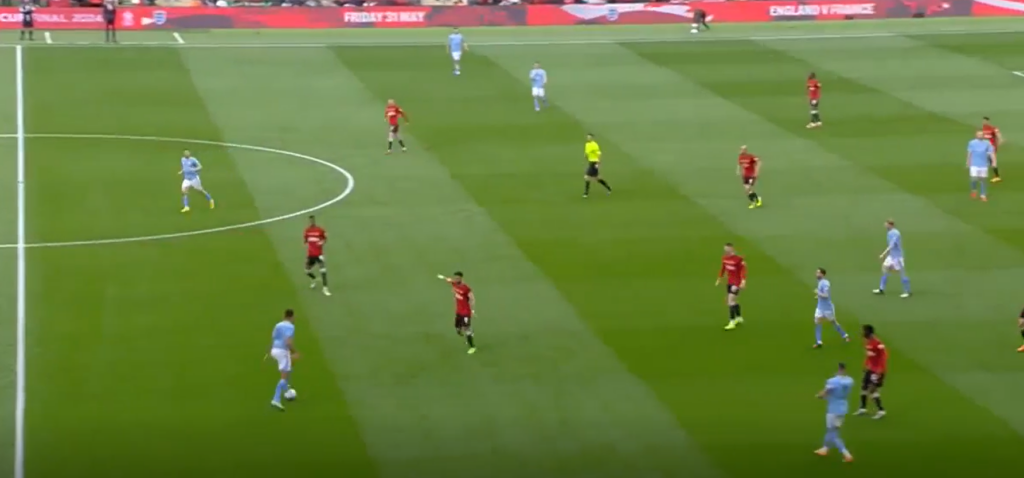
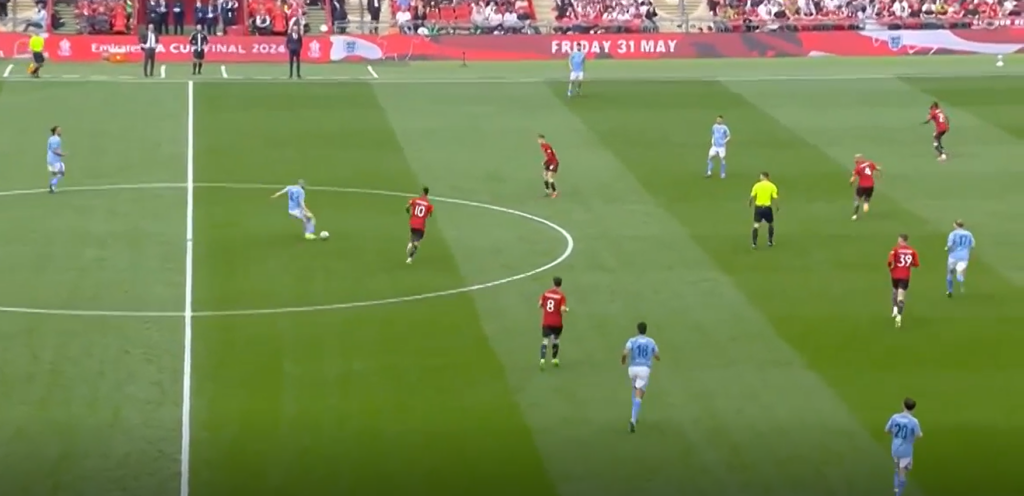
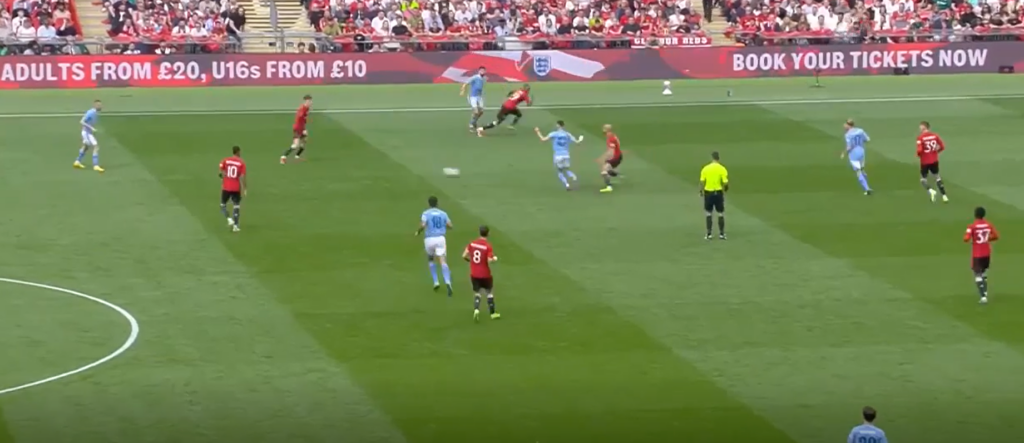
When United lost possession, they aggressively counter-pressed City, trying to catch them out as they transitioned from defence to offence—a moment when teams aren’t always fully organised. This caused City a few problems, like in the sequence below, where United played through City after winning the ball back, worked extremely hard upon losing it to press City, and almost won the ball in their box twice.
In the attached clips, we can see just how different United was in their pressing intensity in this game. Players were quick to act rather than react, constantly on their toes. Their intensity was good, and they were quick off the mark, which gave City less time on the ball. Players also felt a lot more coordinated. There was the hunger to hunt the ball down in packs, and it stifled City’s possession a lot.
In-possession approach – creating the moment
United didn’t see much of the ball at Wembley; few teams do against Manchester City. So when they did have it, they had to be productive with it.
After the 4-3 win over Wolverhampton Wanderers, one of, if not United’s best performances of the season, I spoke about how, with a fully fit squad, United would frequently look to change the picture of the attack and create the moment—looking to manipulate the space to open Wolverhampton up before aggressively attacking it with their fast, direct running quality.
Whilst the tactical approach was, naturally, different against City, Ten Hag’s side followed this same principle. When they did have the ball, they would often be patient for a few moments and try to move City around before looking to send their runners away in the channels, going 1v1 against City’s centre backs—where they were uncomfortable.
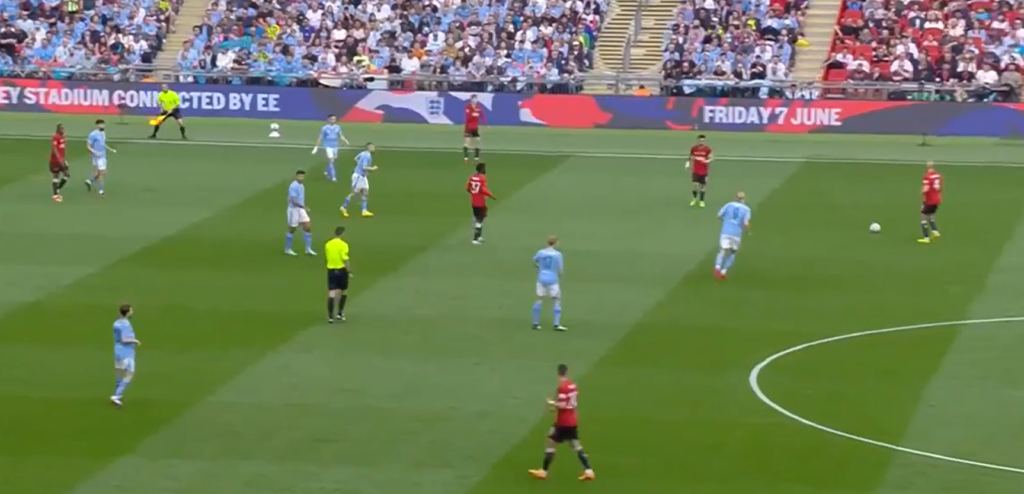
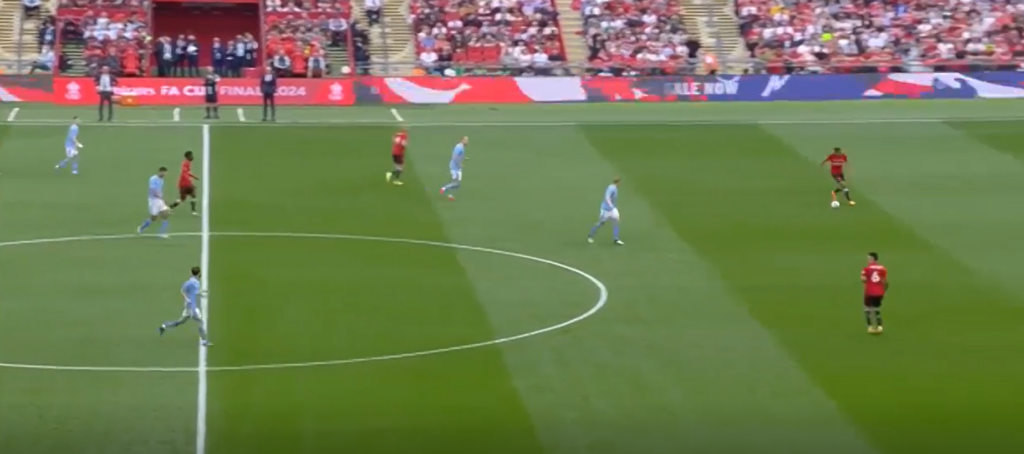
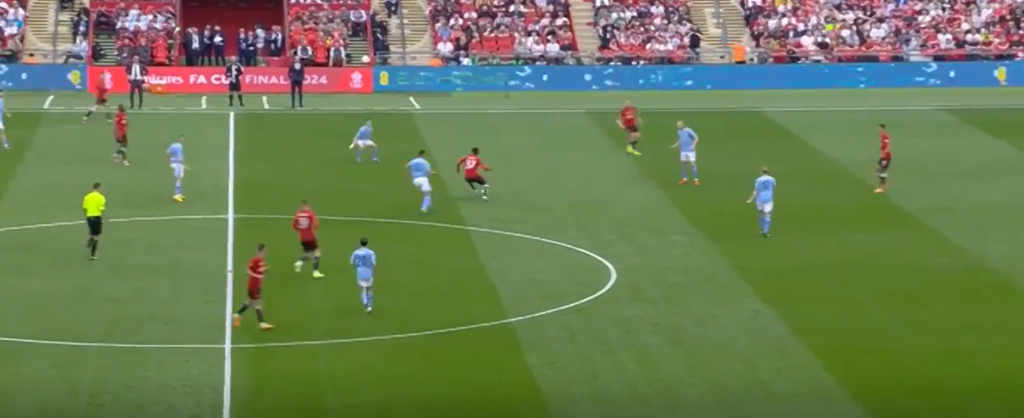
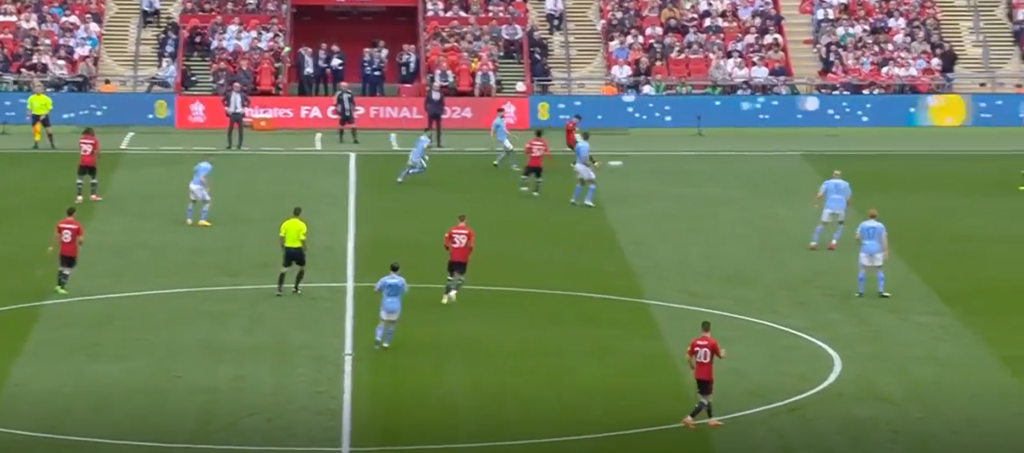
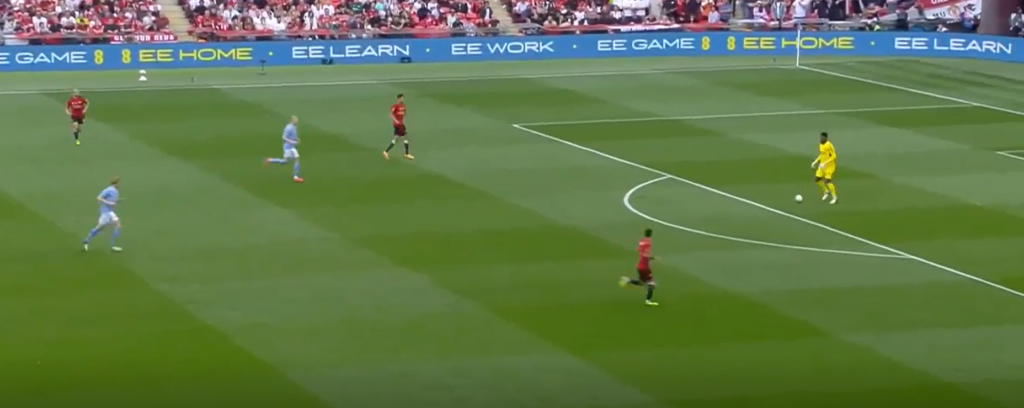
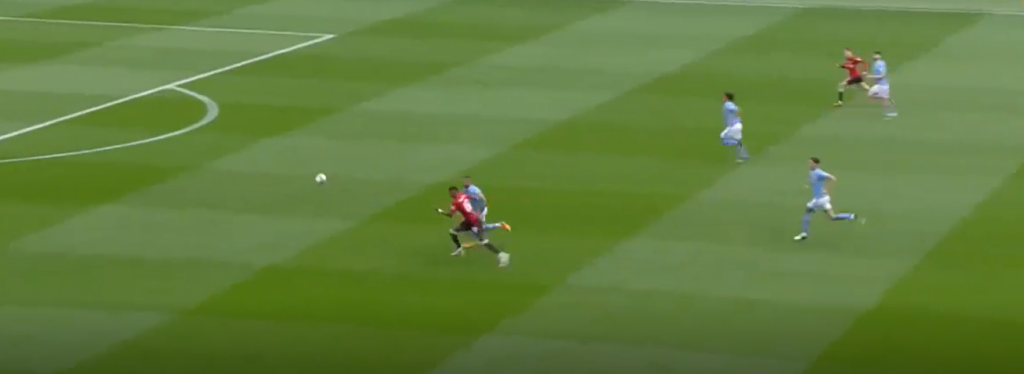
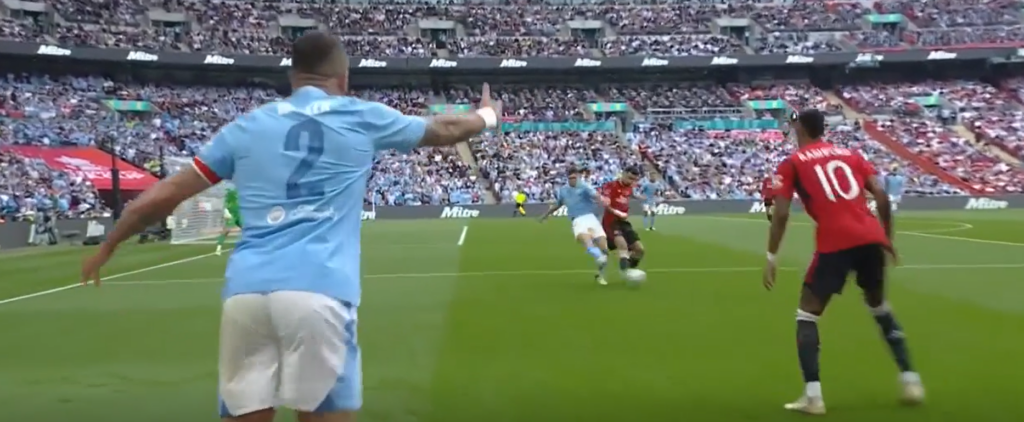
United created one of the aforementioned wide rondos from the resulting throw in, winning the ball by outnumbering City before playing around them and working the ball over to Garnacho, who was able to get a shot on goal and test Ortega.
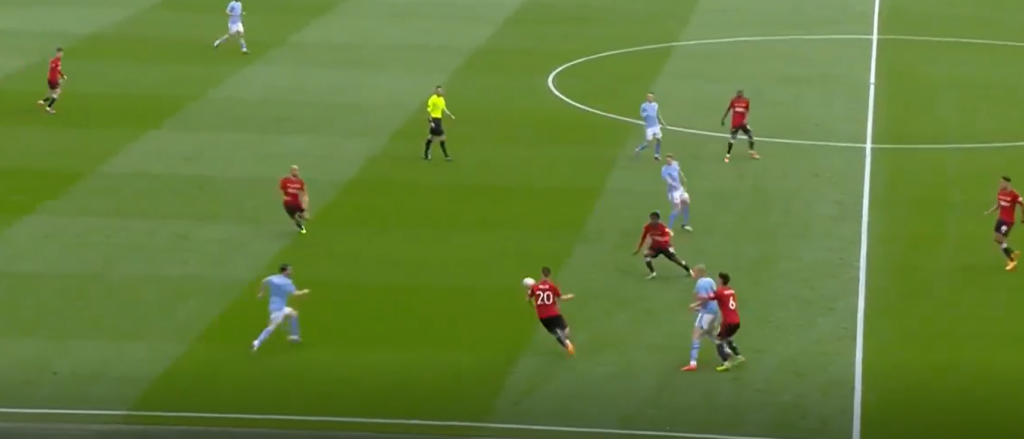
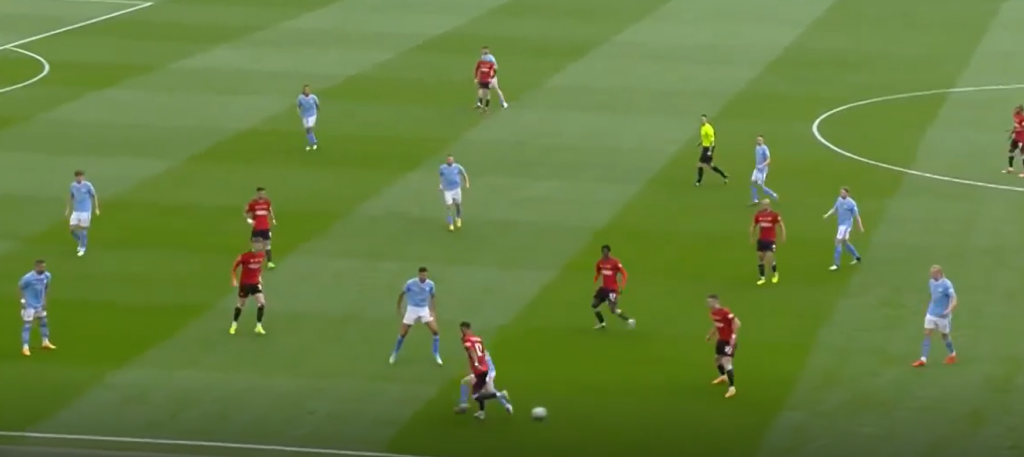
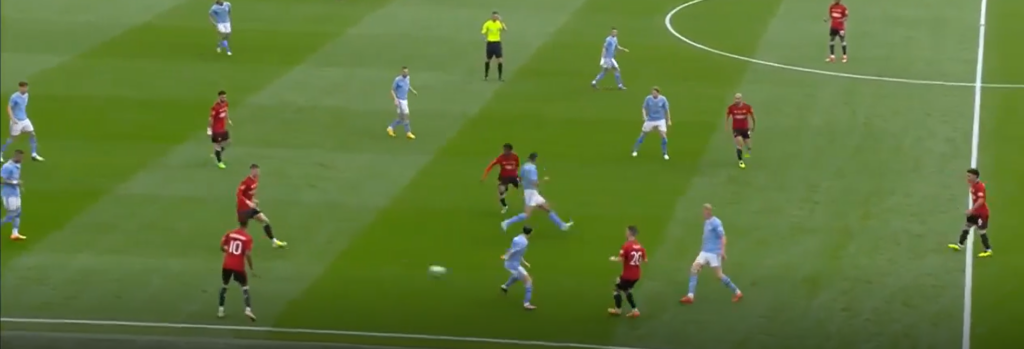
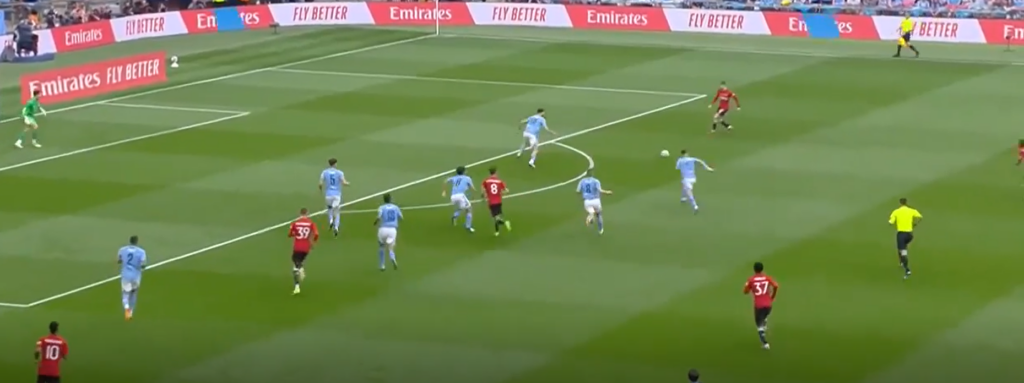
Going into the second half, City amped up the pressure, but United stuck to their gameplan and looked to exploit the spaces left by this. In the opening minutes, they caused City some trouble when they had the ball, in the below example, almost finding Rashford 1v1 against Ortega after an up-back-through pattern.
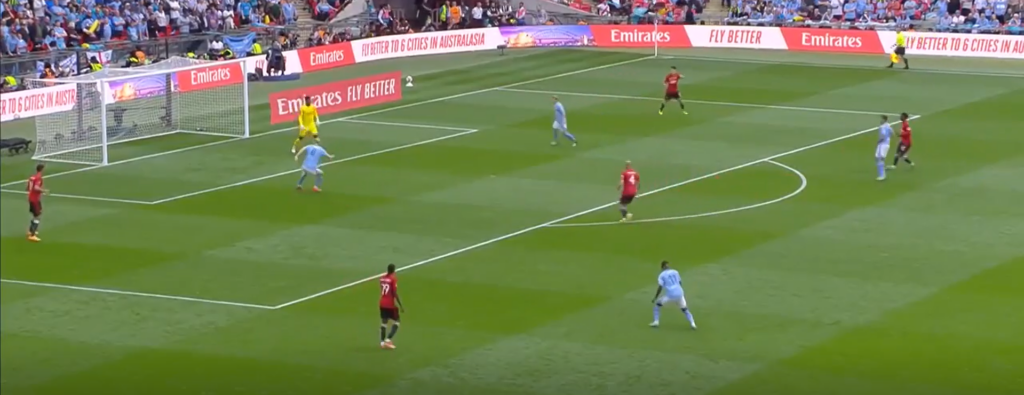
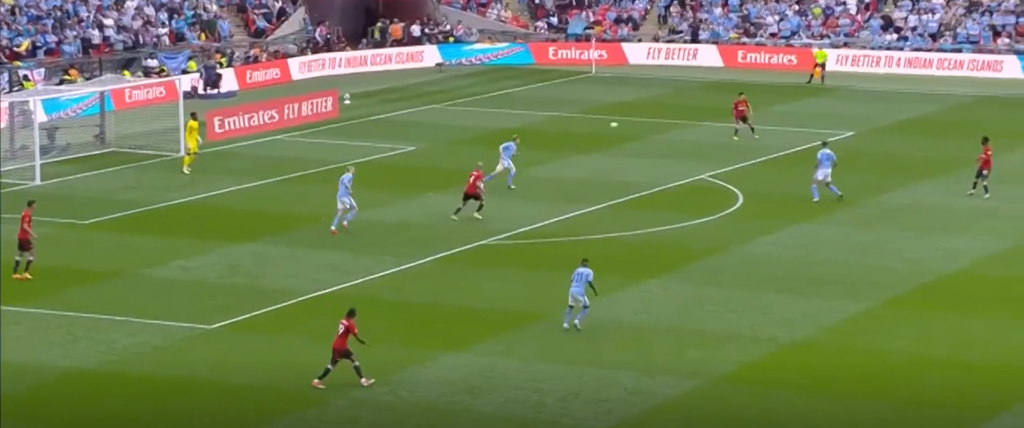
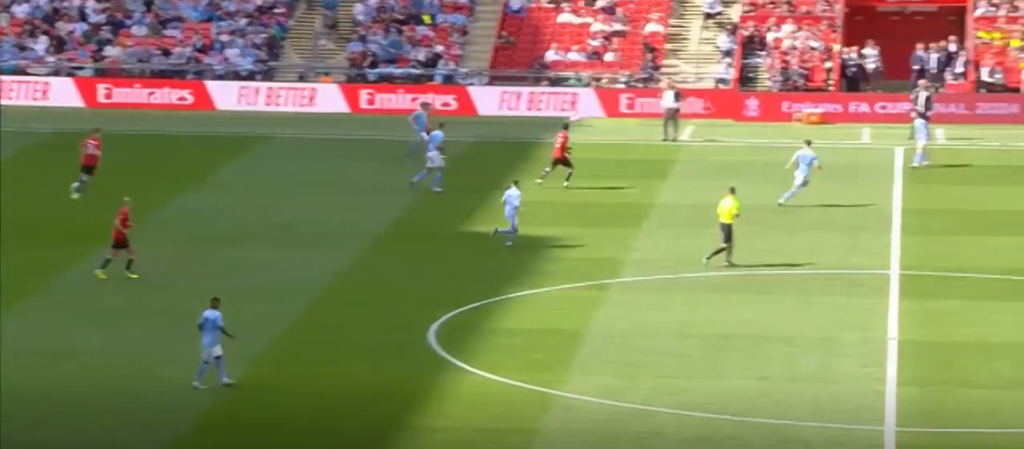
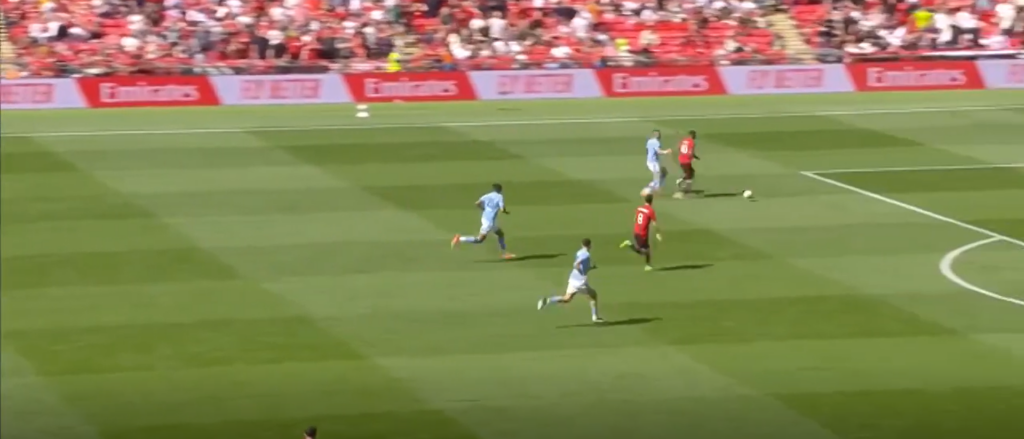
Analysis: Goals & offside goal
We saw these principles in place for the first goal. United played around the defence from a goal kick before going long. The ball went to City but returned to United after an incredibly sloppy pass from Rodri.
Sofyan Amrabat carries the ball back towards the touchline, dragging sky blue shirts over with him, before passing backwards to Diogo Dalot, who has space to receive the ball facing inside the pitch. He plays over the City backline to find Garnacho’s run on the other side – did well to keep onside – and the forced City mistake gives him an easy tap-in.
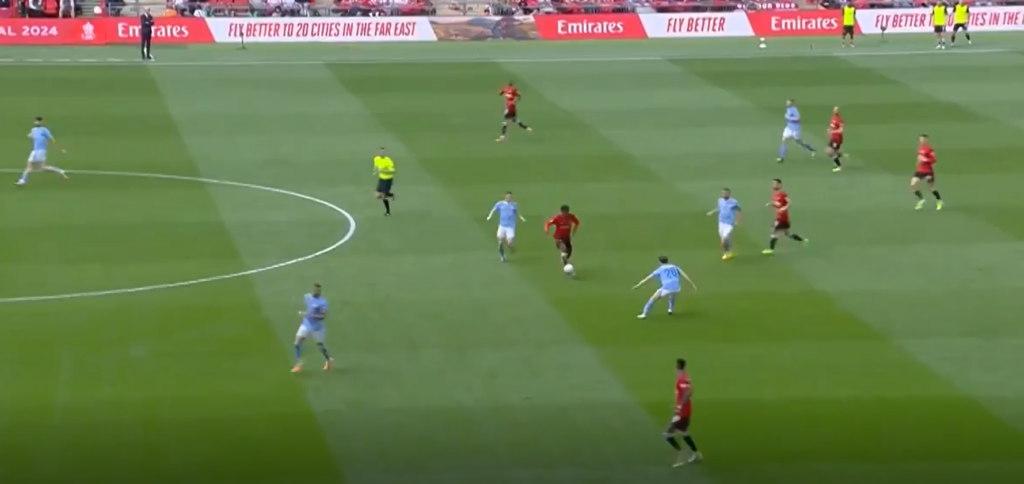
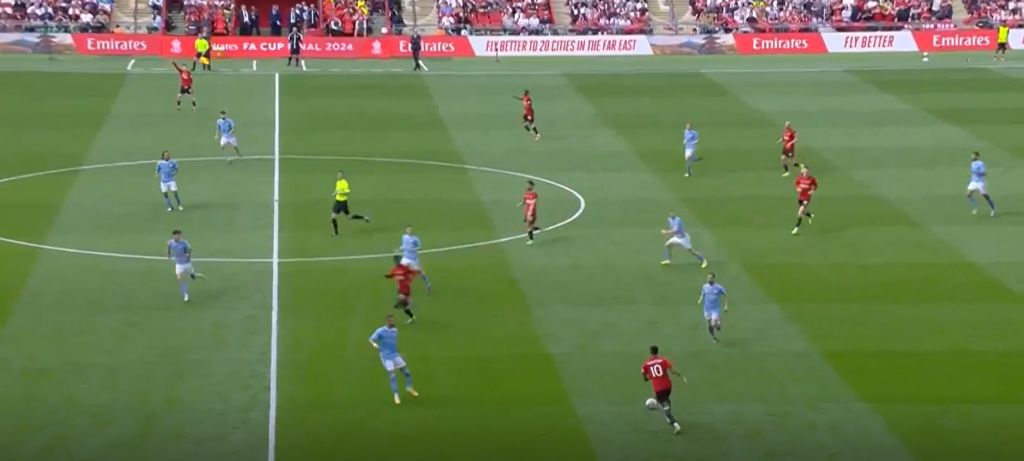
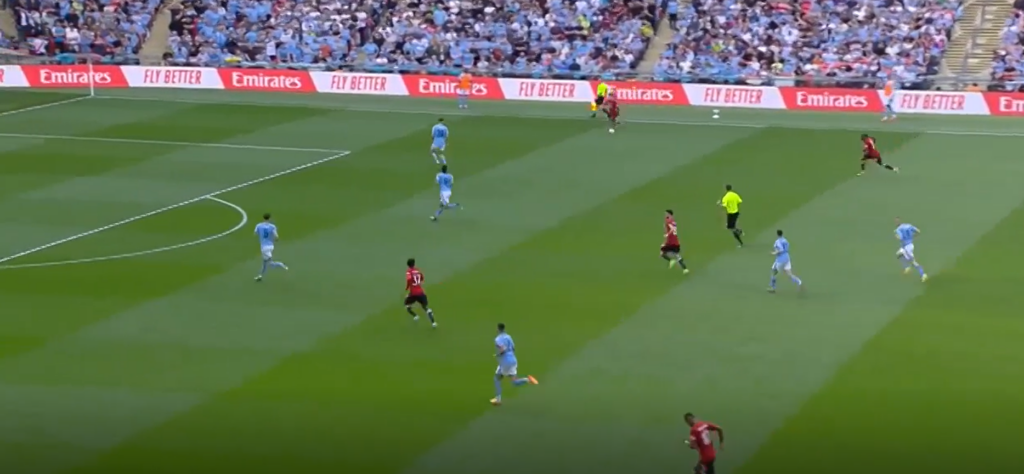
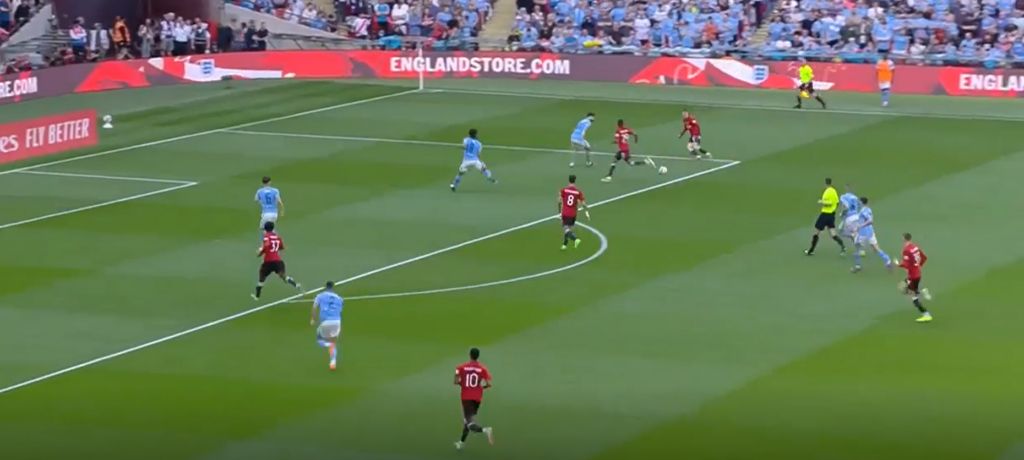
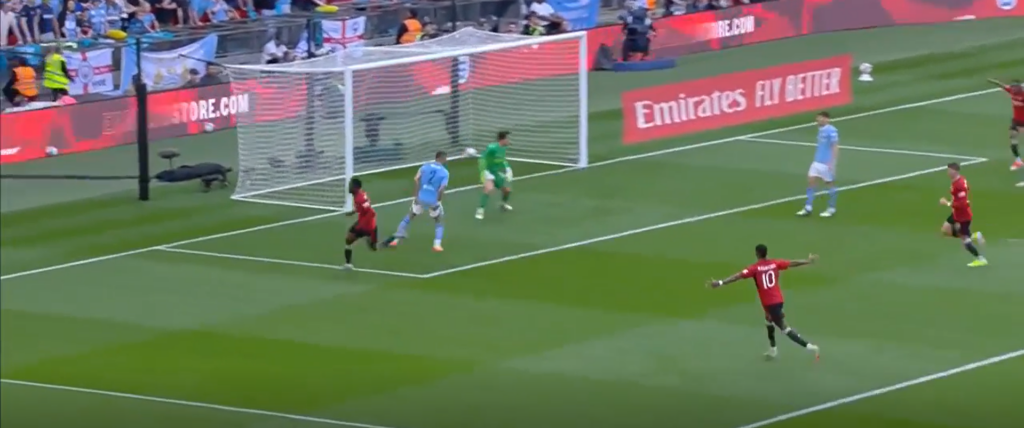
Similar principles are in place here. The clear aim is to create the moment by pulling teams into space before changing the picture of the attack and exploiting the space left.
As a bonus, we will analyse the offside goal scored by Marcus Rashford.
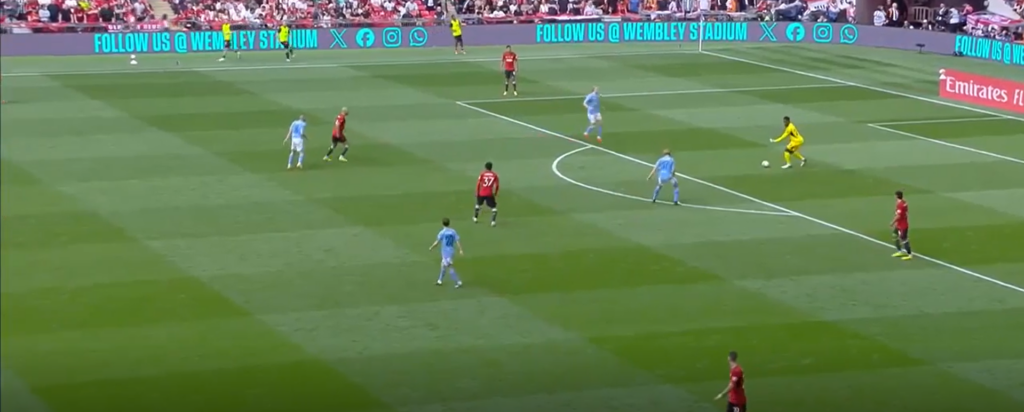

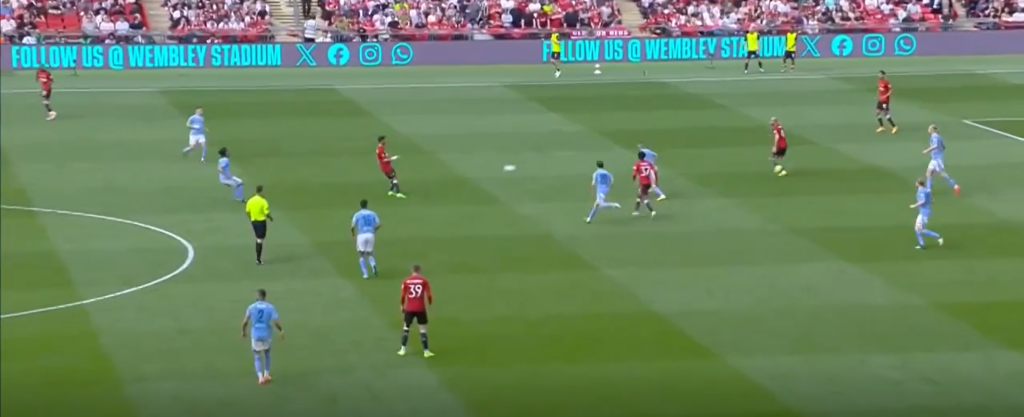
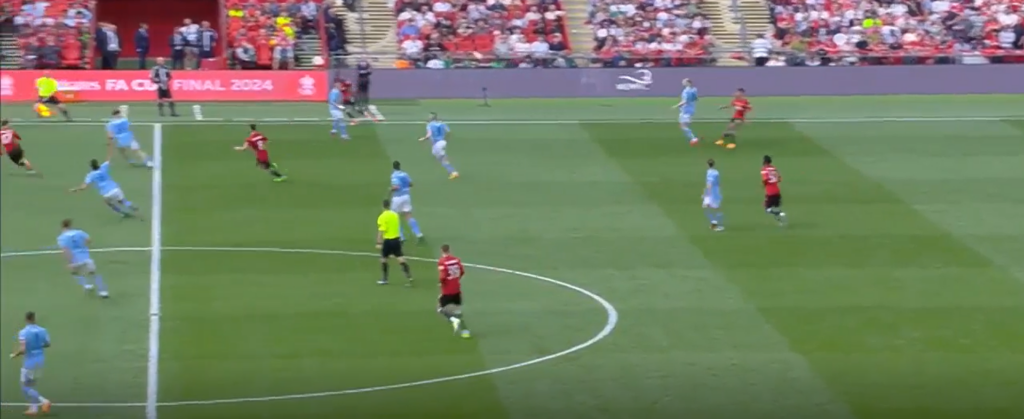
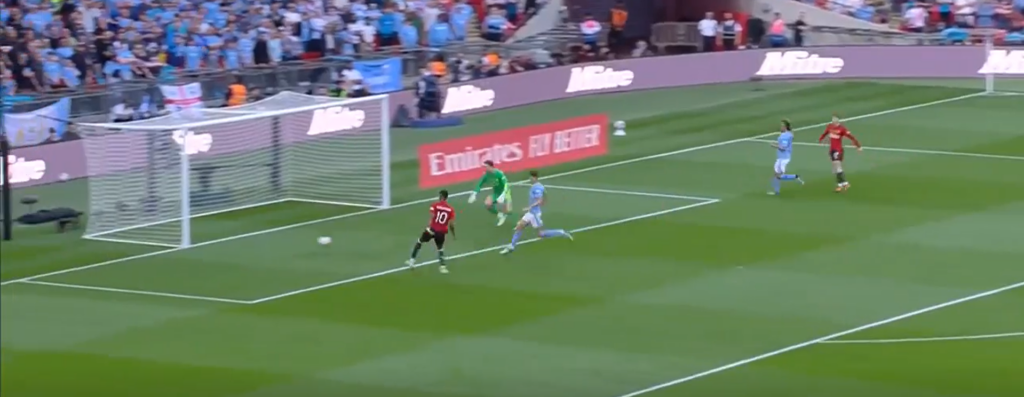
This was an example of the up-back-through pattern, something that was seen a few times in the final and has been used during the season when the right players are available in the middle. It is an effective way of creating and exploiting space, and if Varane had passed slightly earlier, then Garnacho would have been onside.
Second half – Securing the win
At half-time, Manchester City made two substitutions, which changed their dynamics. One was to bring on Jérémy Doku for Mateo Kovačić and Manuel Akanji for Nathan Aké, with Phil Foden moving into midfield. This changed City’s dynamics, but United kept similar principles defensively.
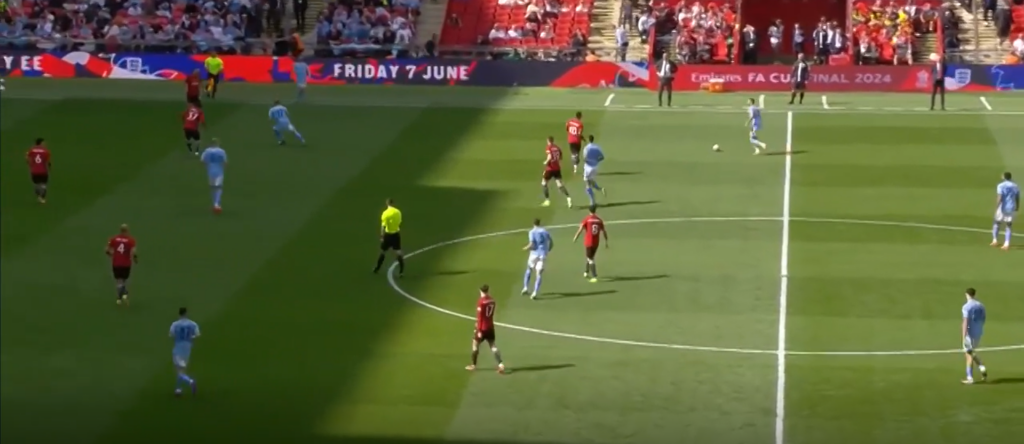
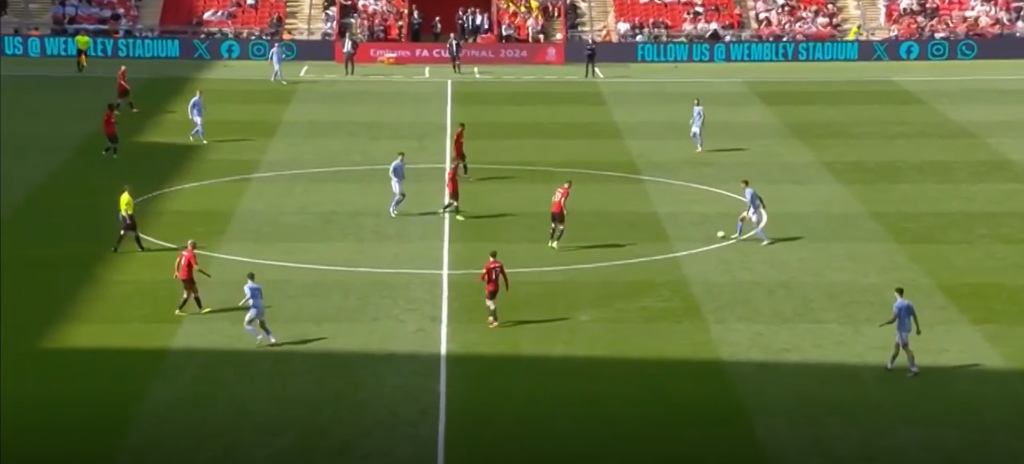
United started the second half again by maintaining their approach of blocking the middle and not letting City play through them. Fernandes and Mctominay block the ball into Stones. Garnacho and Rashford are well-positioned to press City’s narrowed full-backs should the ball move sideways, and Mainoo and Amrabat are tight to City’s two number eights.
The dynamics changed particularly in the wide areas, with Doku as the left winger offering a very different threat to the one offered by Phil Foden. The second half required more from United’s full-backs in how they handled their 1v1s, but they did this well. The below sequence highlights a lot of different aspects of United’s gameplan.
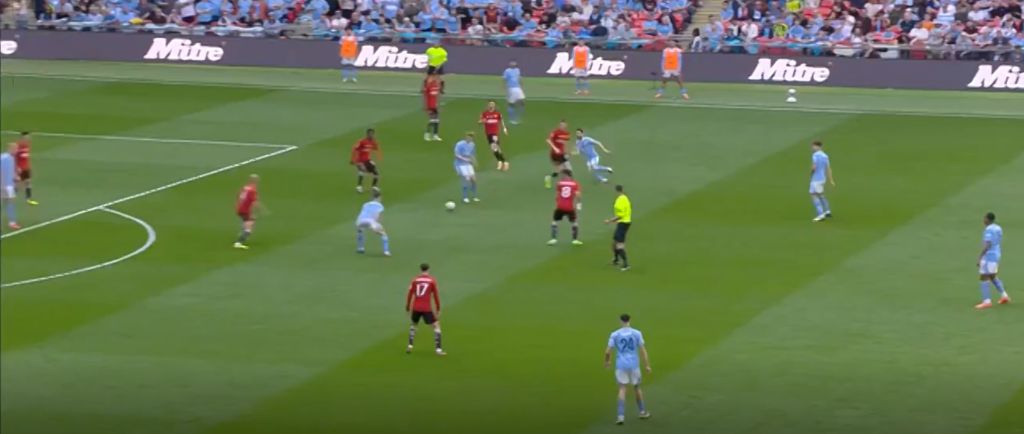
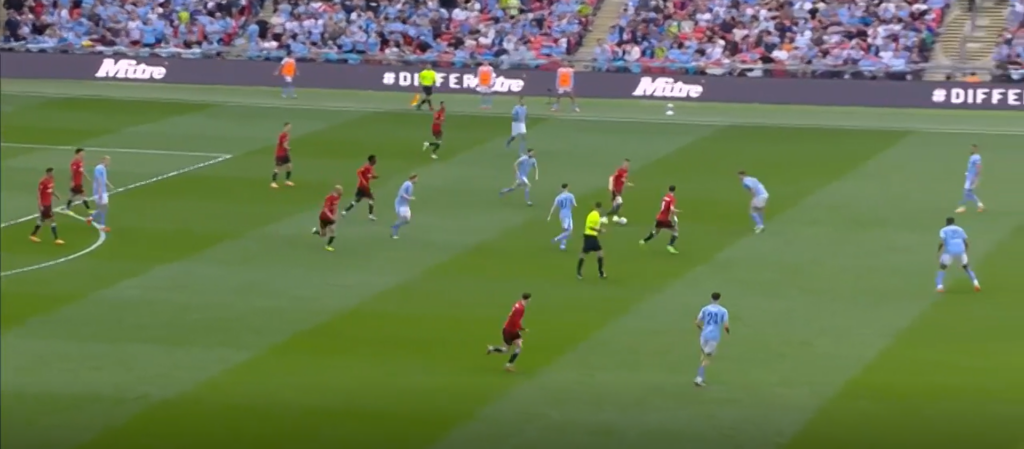
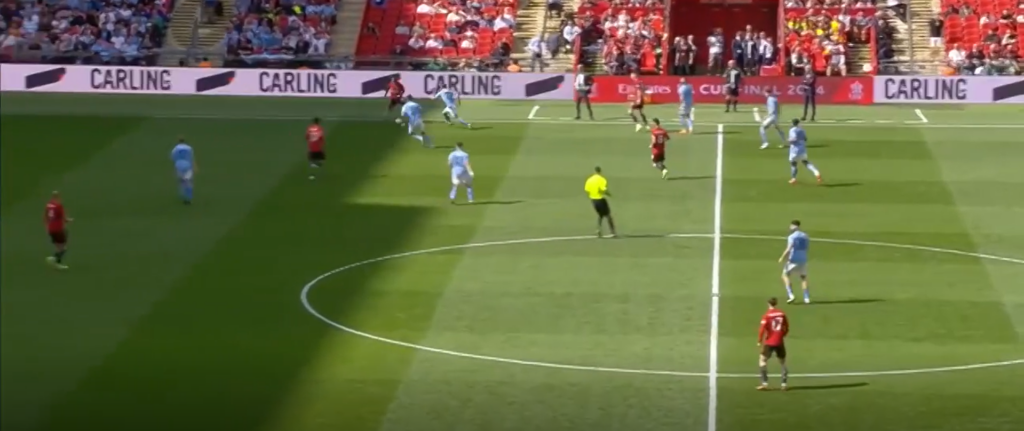
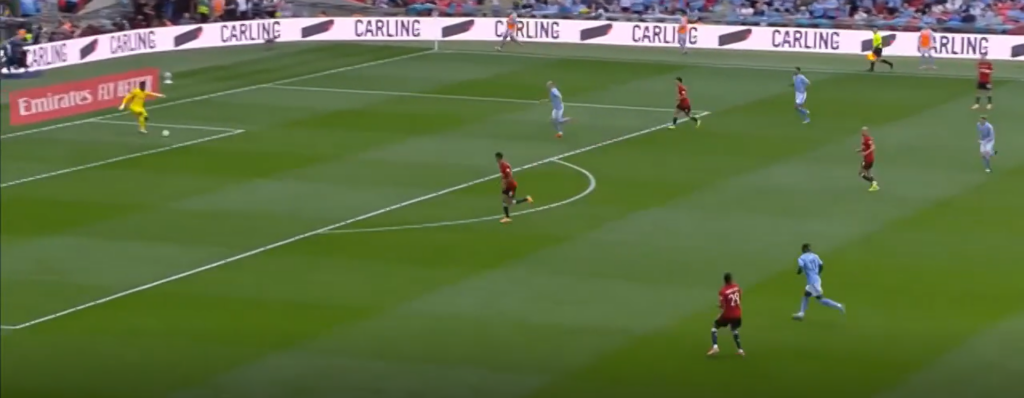
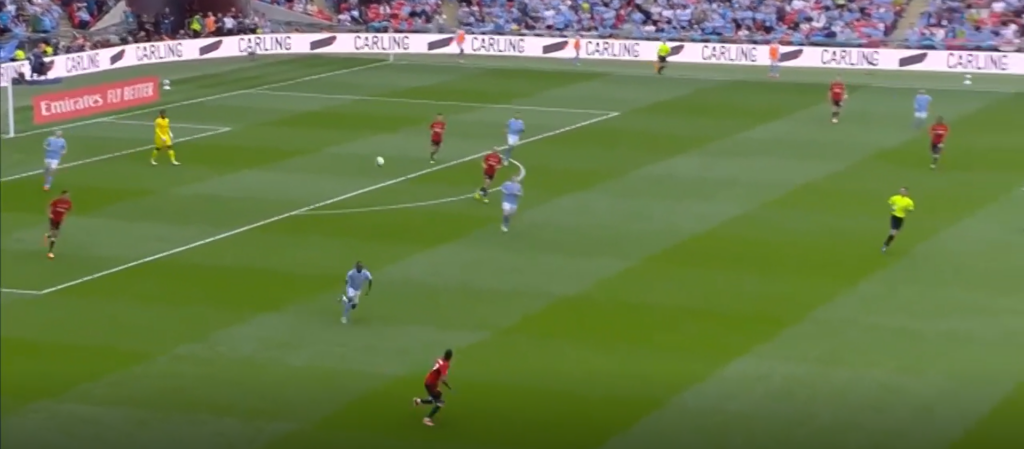
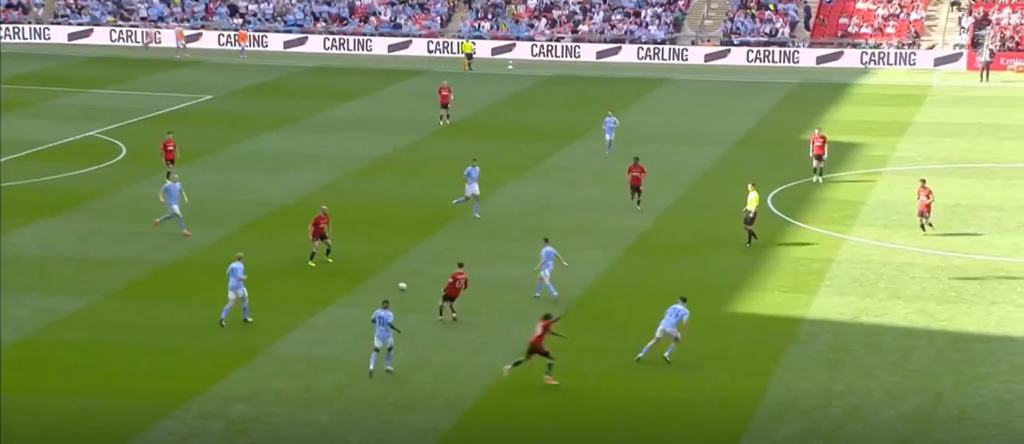
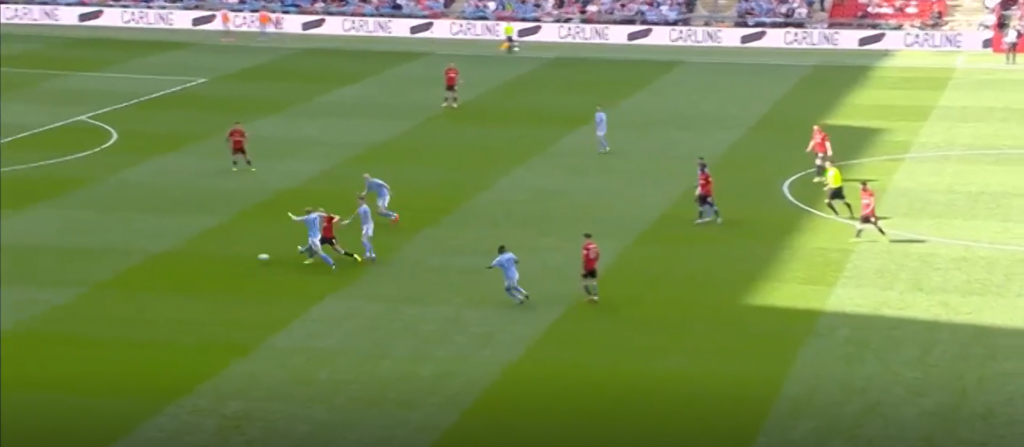
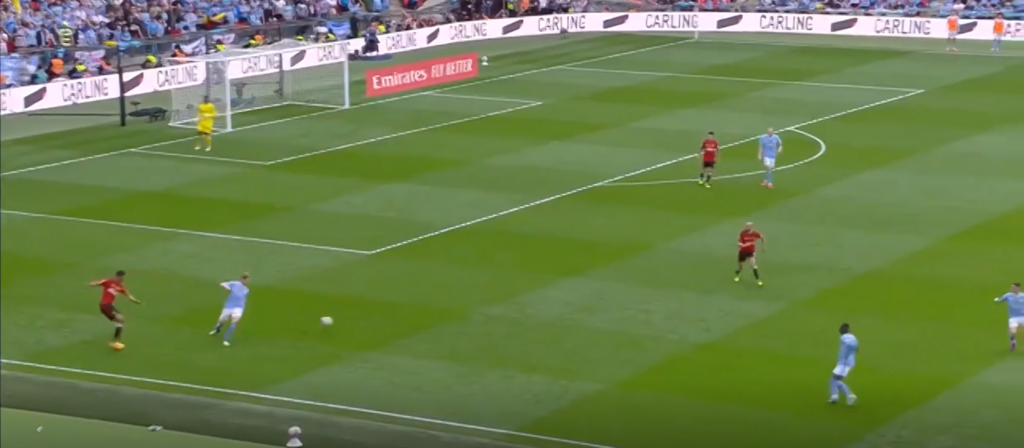
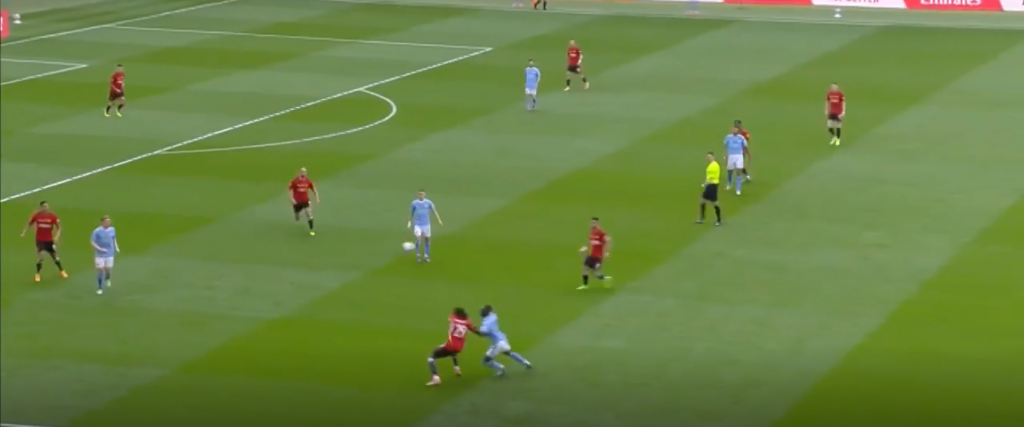
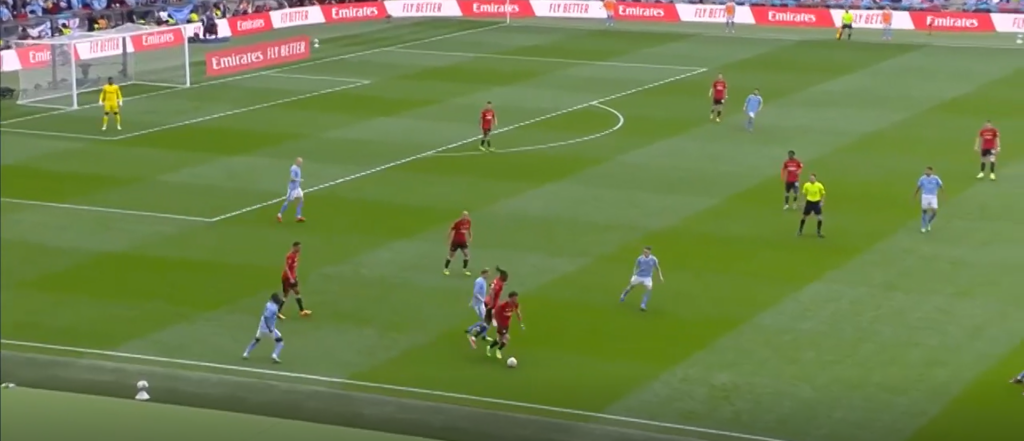
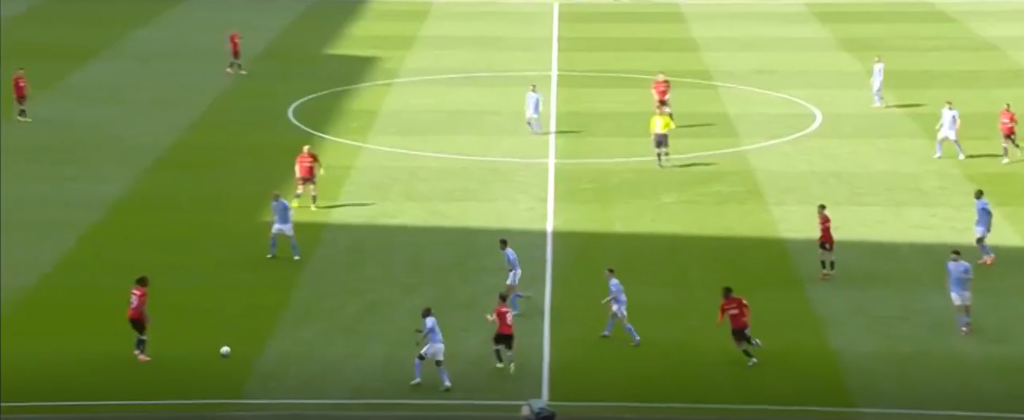
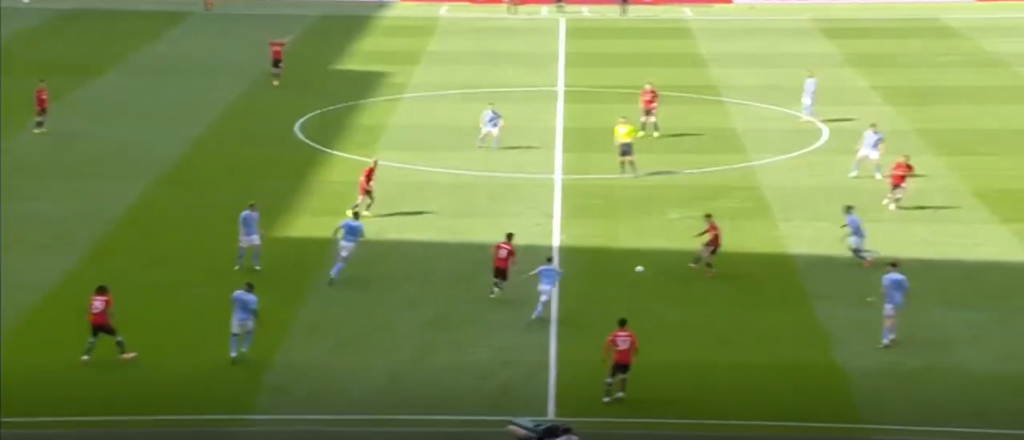
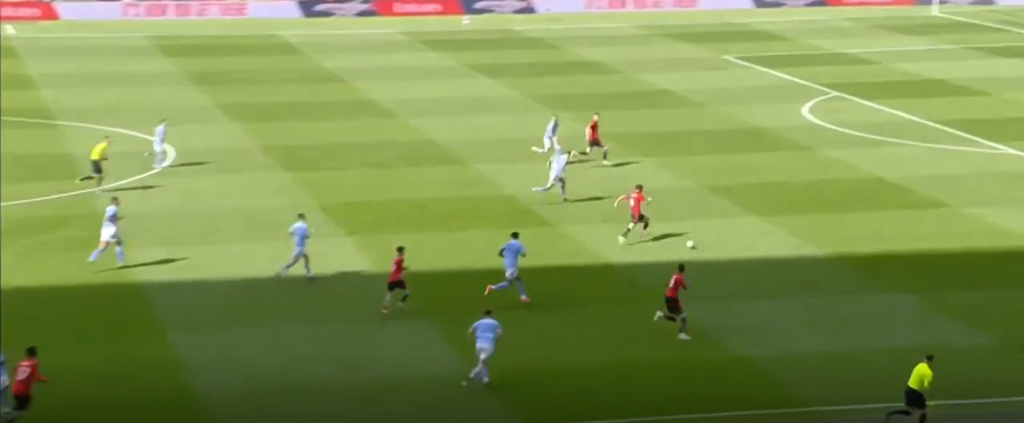
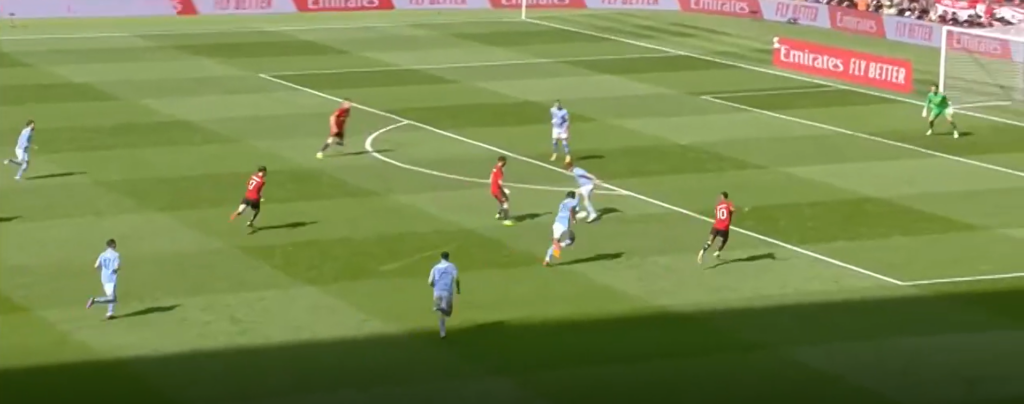
This sequence was long but it was an excellent play from United and displayed many aspects analysed so far in this article. The aggression and intensity in the 1v1 duels, creating the moment, and dominance in wide rondo situations were all on show in this sequence. Principles.
United would counter-press aggressively after losing the ball here, and Mctominay would win a free kick after picking up Gvardiol’s loose touch.
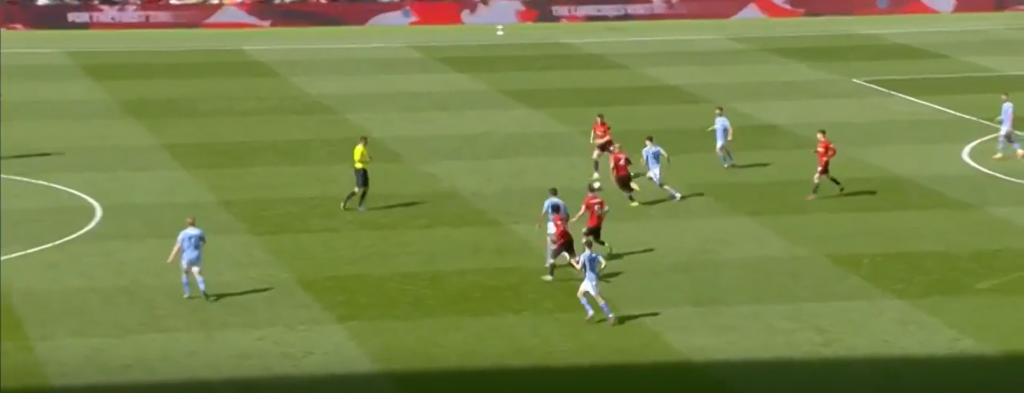
One of the dynamic changes created by Doku’s inclusion was that when the ball spread wide, City would often try to overload the central areas in and around the box.
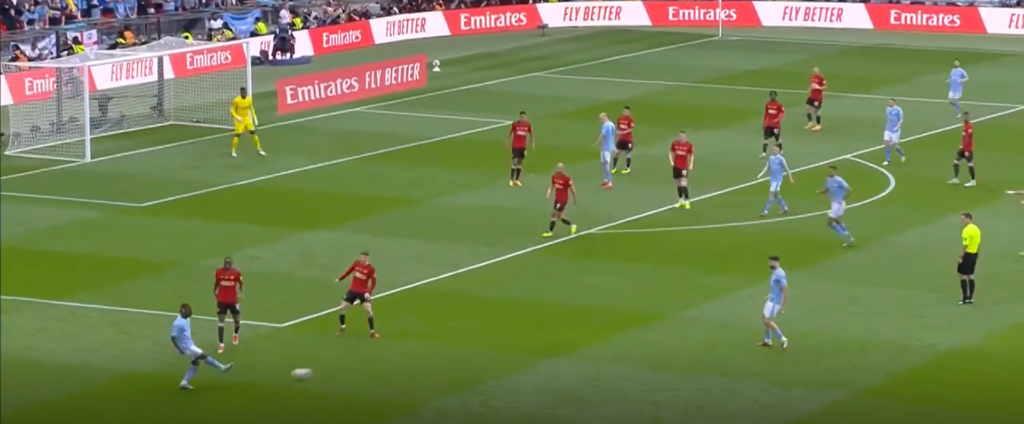
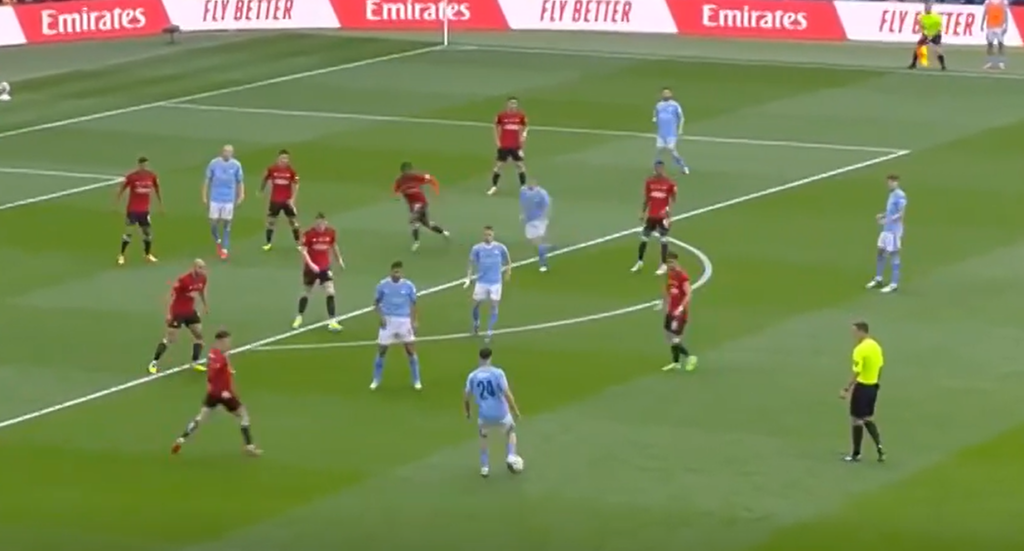
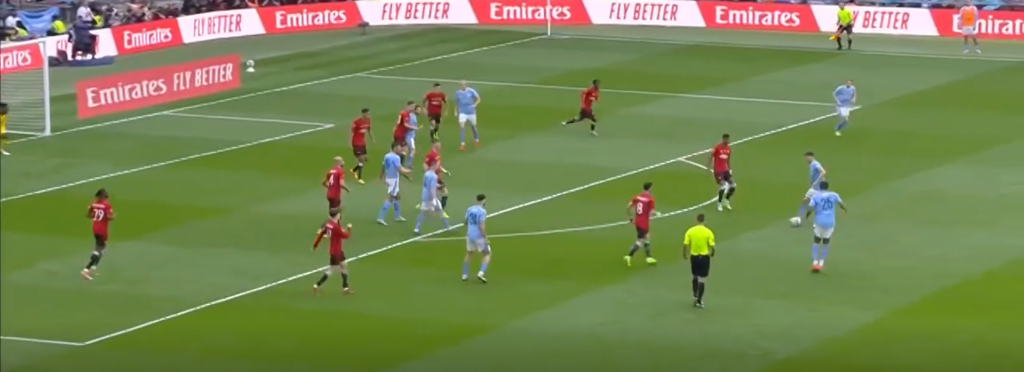
City’s best moments would come when Doku was receiving wide and City supported him with runs to open up spaces in the middle rather than camping there, in these situations United did struggle.
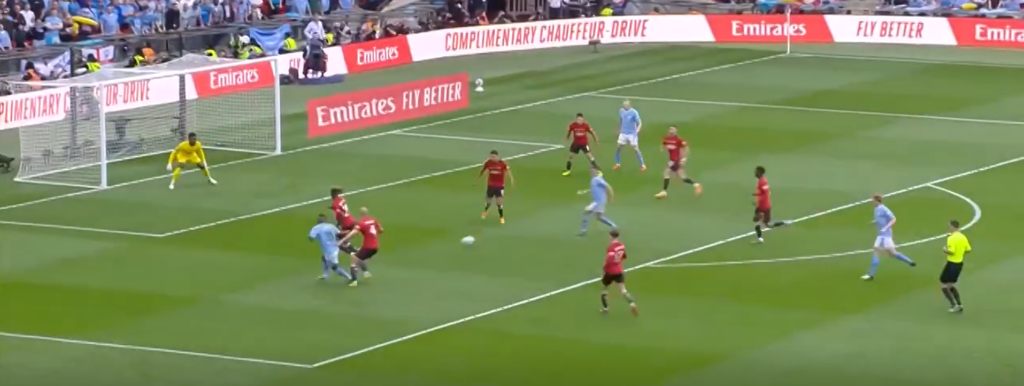
Much of the half played out like this: City probing United’s stubborn block and United refusing to give in for the most part. At one point, though, players did switch off in the middle, and City would have their best opportunity of the half.
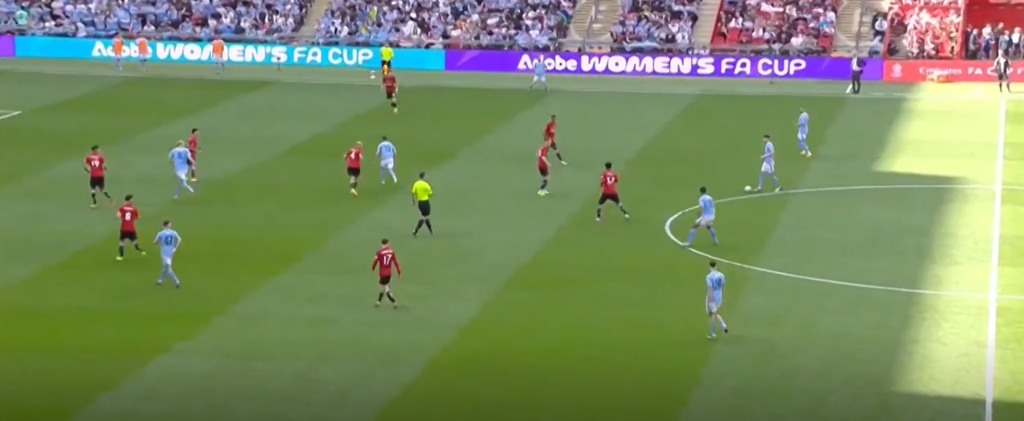
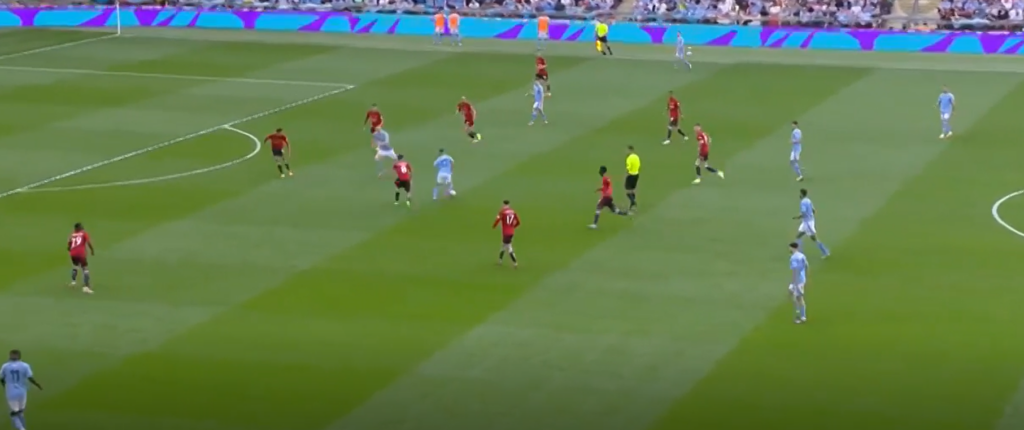
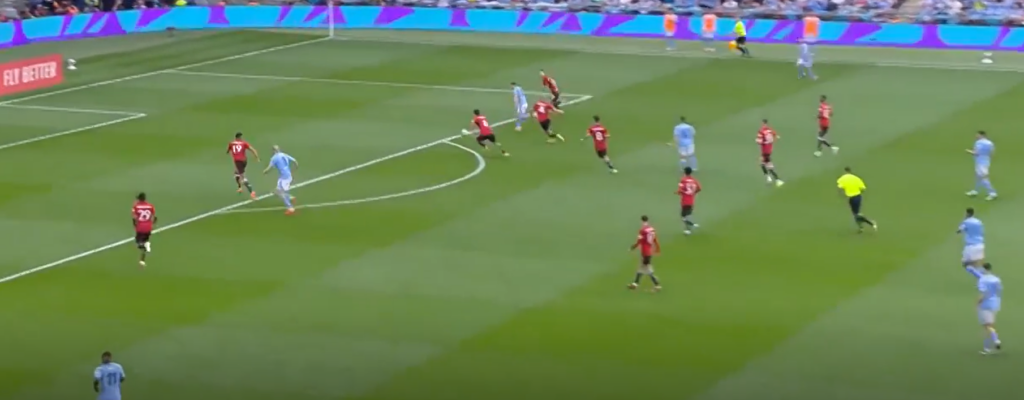
Other than this, most of City’s best opportunities came from long-shot attempts. Kyle Walker tested Onana on a couple of occasions, but the Cameroonian goalkeeper made some excellent saves.
United brought on Rasmus Højlund towards the end of the half, and his pace and physical power were causing big problems against City’s backline, who struggle against powerful and direct attackers that will run at them relentlessly.
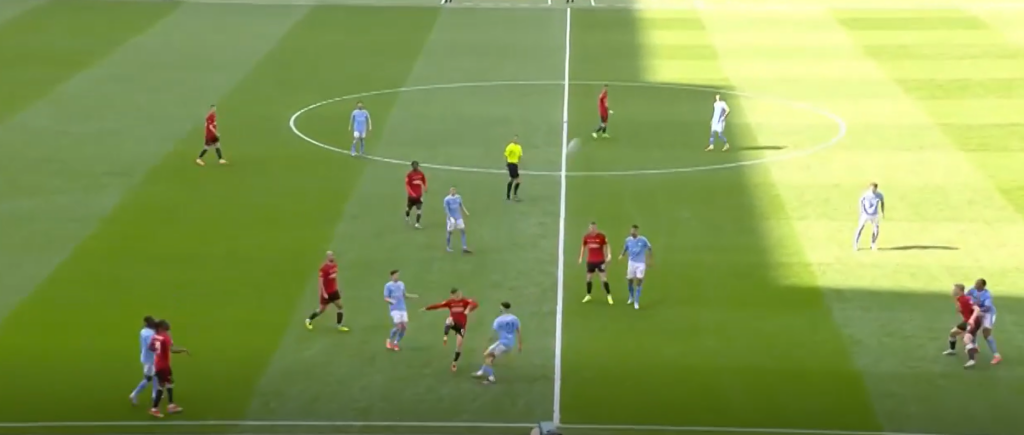
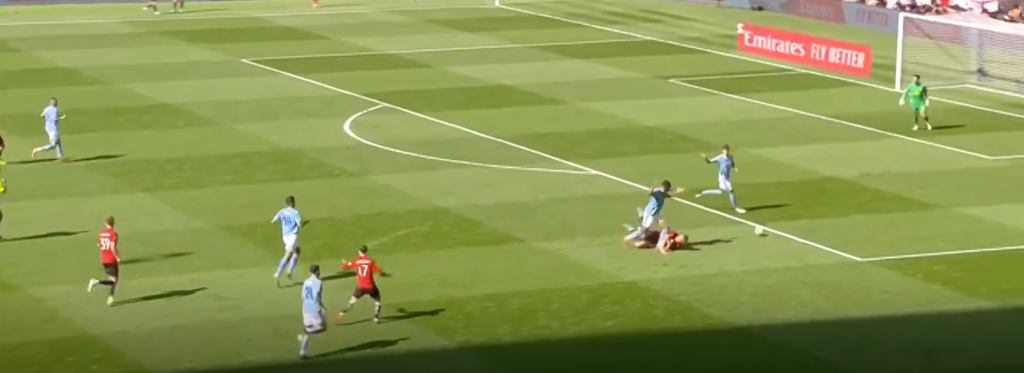
With minutes to go, City equalised from a Doku long shot that Onana really should have saved – a shame given his excellent performance.
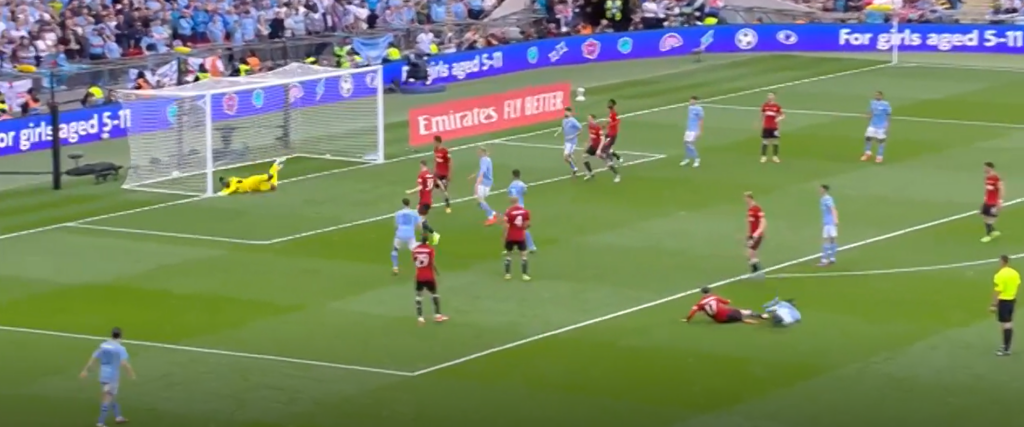
Now, the pressure ramped up for United, but the players all stepped up to match that. Everyone did their job defensively, and the forwards were smart on transition by looking to keep the ball and run the clock down rather than looking to score another goal and be the hero. Onana made one incredibly strong claim from a corner in the 92nd minute, bouncing back from his previous error.
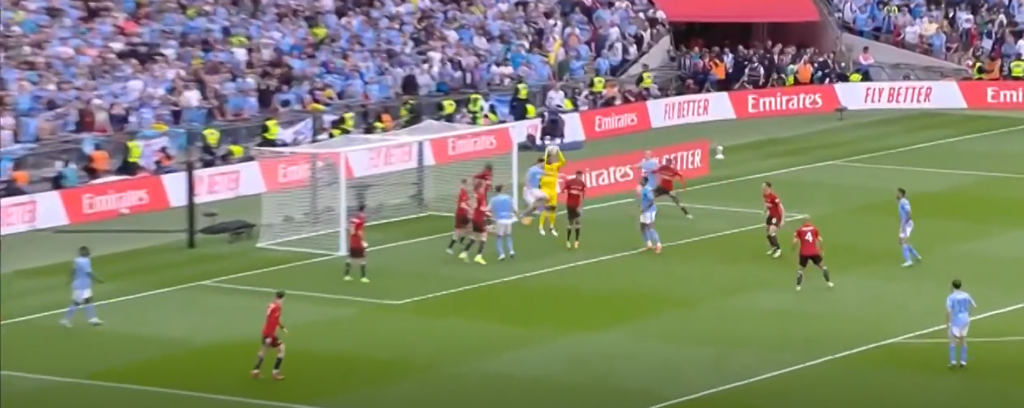
Ten Hag would bring on Victor Lindelöf for Alejandro Garnacho – a real warrior of United’s season despite ups and downs in his form – and Mason Mount for Scott Mctominay – another player who really stepped up for the club this year – who was struggling with a knock, looking to see out the game.
Mount’s introduction brought energy, intensity, and smart pressing to United’s play. He closed the ball down excellently in the final minutes, stopping City from getting opportunities to really test United and rushing their decisions in an already frantic state.
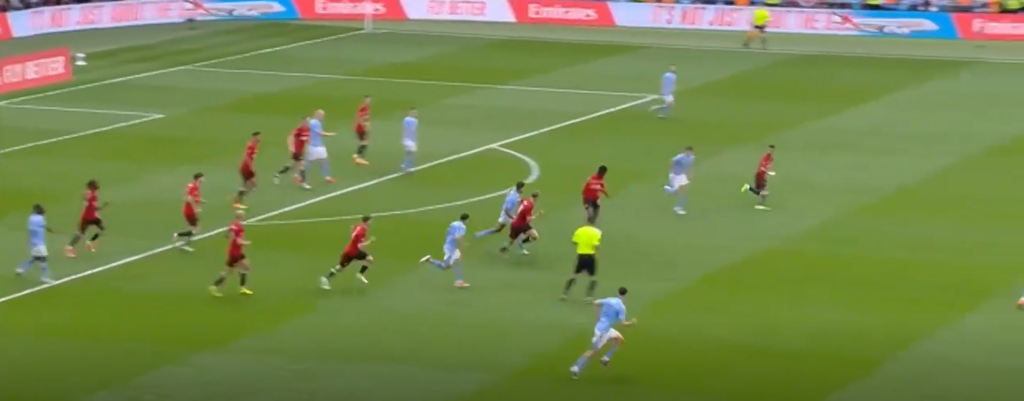
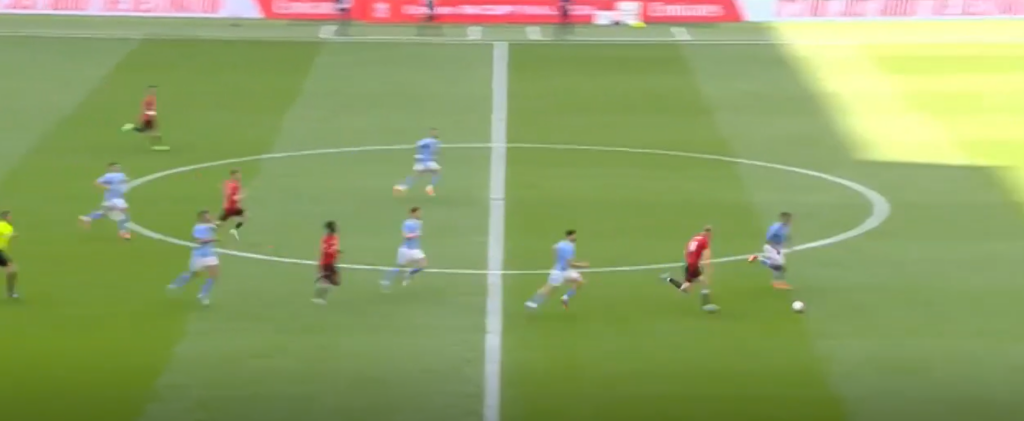
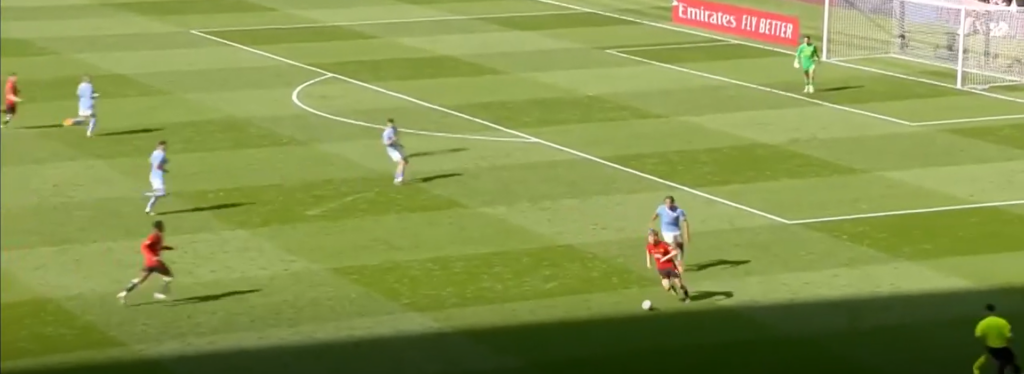
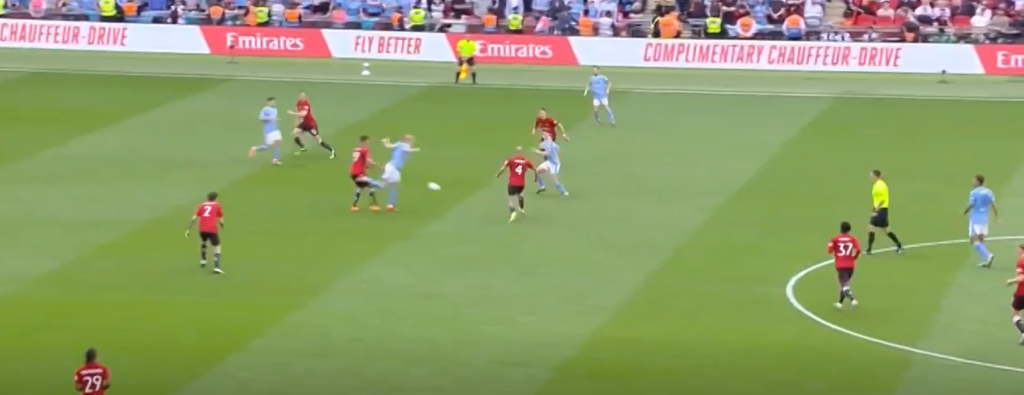
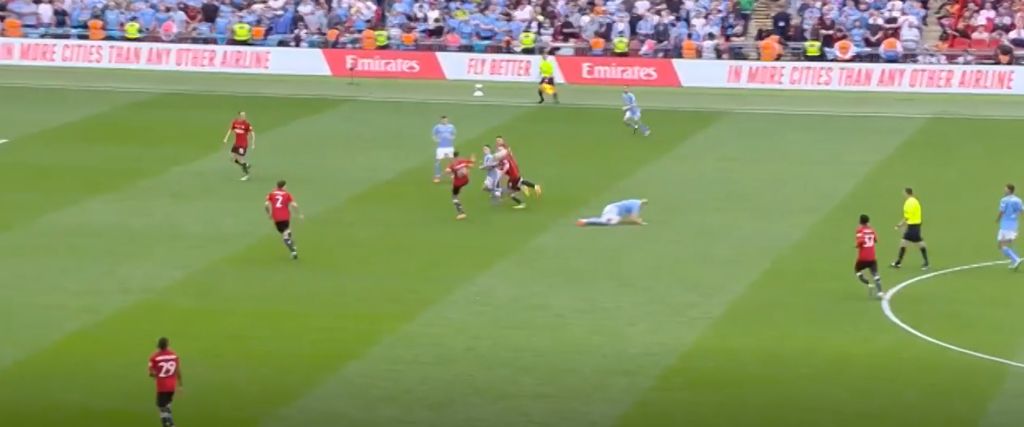
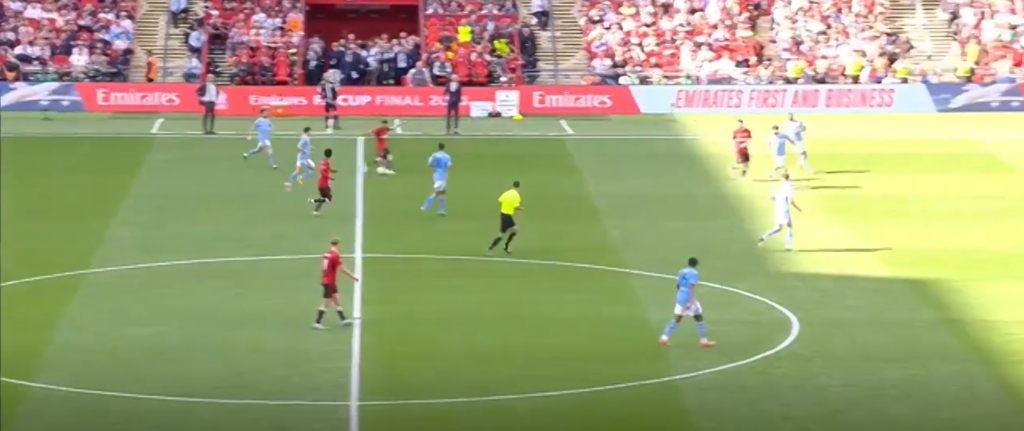
The last play of the game was a brilliant one, with United blocking a Walker long shot and clearing the ball before Højlund once again put the burners on and showed just how scary his speed is, burning Álvarez.
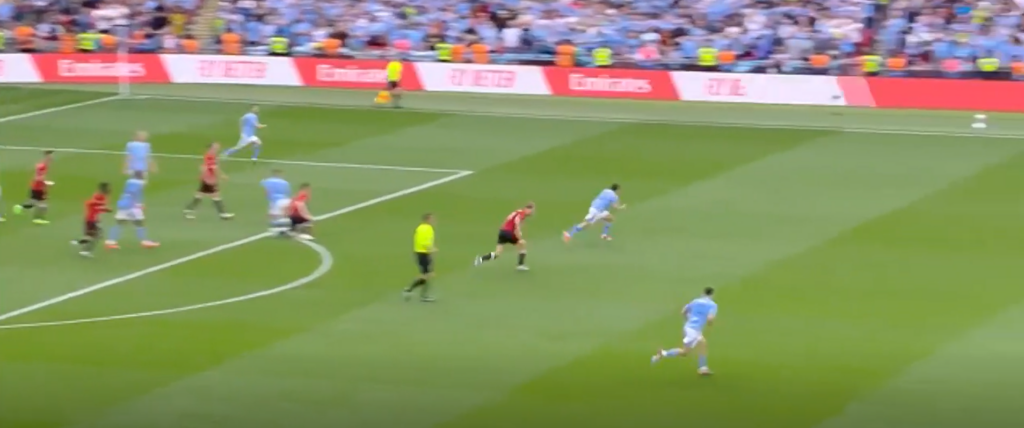
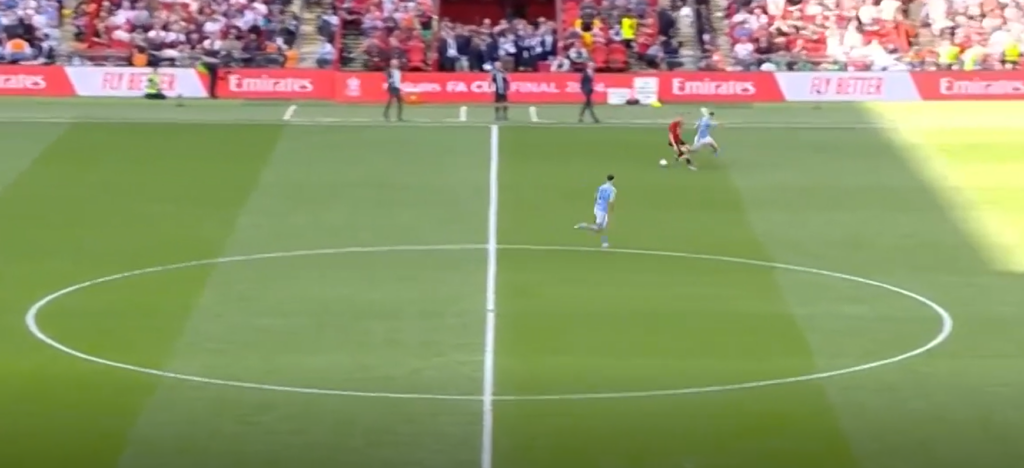
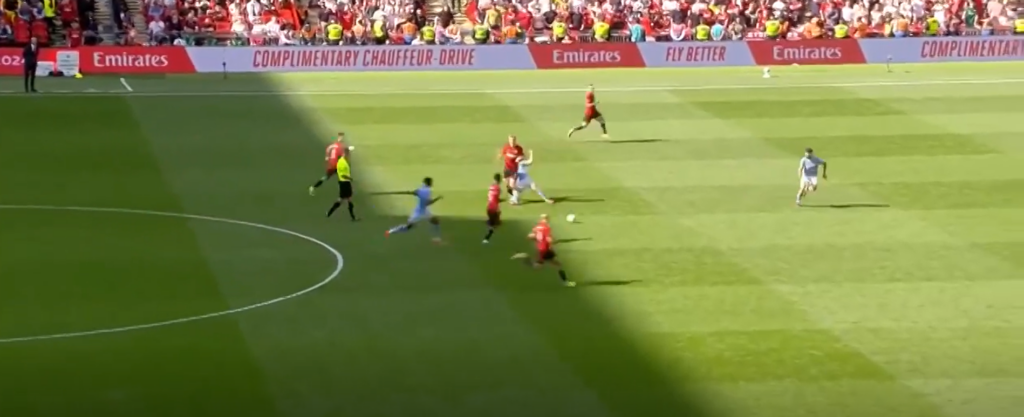
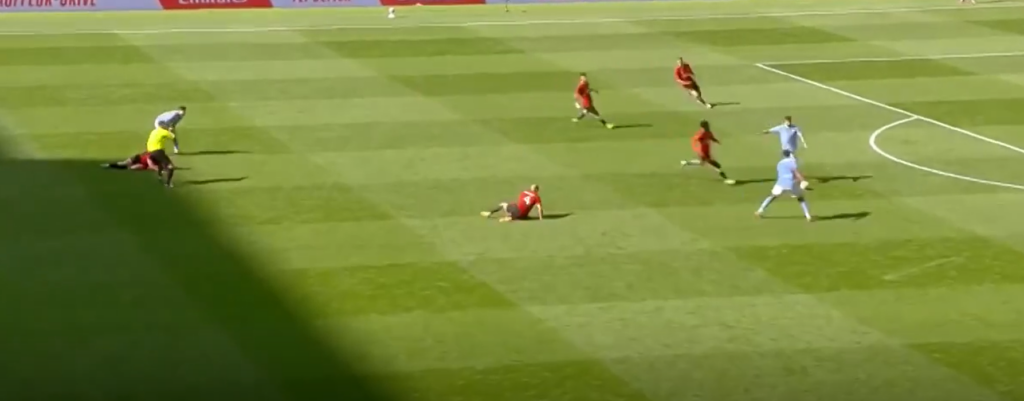
The referee blew the whistle immediately after the game, concluding what was an incredibly well-deserved win from United – who executed their game plan almost perfectly. The future of Erik ten Hag remains up in the air, but if this was goodbye then it was the best way in which he could have said it.